
TSM | Cronologia | Onomastico | Glossario | Thesaurus
Il repertorio polifonico in notazione quadrata si può suddividere cronologicamente in due parti. Un primo gruppo databile a metà del xiii sec. comprende fra l'altro i codici più importanti della scuola di Notre Dame:
| Egerton 2615 | Redatto forse a Beauvais, presso Parigi (ca 1240, ma la sezione polifonica è più tarda). È il ms in cui, oltre al Viderunt omnes di Perotinus, compare anche la musica monodica del Ludus Danielis |
| Wolfenbüttel 1 | Esemplare redatto in Scozia (ca 1240) della scuola di Notre Dame |
| Monaco 4775 | Codice compilato verso il 1250; danneggiato durante la guerra, rimangono poche pagine e alcune riproduzioni fotografiche — Münich, Gallo-rom 42 |
| Cod. di Madrid | Manoscritto spagnolo databile al 1270 — Madrid, 20486 |
| Wolfenbüttel 2 | Redatto presumibilmente a Parigi verso la fine del xiii sec., contiene i due organa a quattro voci di Perotinus, Viderunt omnes e Sederunt principes |
| Cod. Fiorentino | Insieme ai Wolfenbüttel 1 e 2 è il ms più importante (nonché il più tardo) della scuola di Notre Dame (ca 1280-90), compilato a Parigi |
Un secondo gruppo raccoglie in prevalenza mottetti e adotta forme di notazione più elaborate e vicine alle teorie di Francone:
| Manuscrit du Roi | È il celebre codice M del repertorio francese e W di quello trobadorico (ca 1265) |
| La Clayette | Ms. del 1260-70 (una ventine di fogli con musica) — Paris, N.a.Fr. 13521 |
| Montpellier H196 | La più vasta raccolta ms di mottetti del medioevo, redatta verso il 1270 |
| Bamberg | Contiene un repertorio databile alla fine del XIII sec. compilato a pochi anni di distanza |
| Las Huelgas | Il celebre manoscritto conservato a Burgos in Spagna (ca 1300). |
| Torino | 3 conducti e 31 mottetti (ca 1300) — info (Bibl. Reale, Vari 42) |
| Fauvel | Il manoscritto con le miniature e gli inserti musicali del celebre poema satirico (ca 1315) — Paris, Fr. 146 — Diamm |
Fra le decine di fonti che raccolgono le chansons di trovatori (lingua d'oc, Provenza), pochissime riportano la musica. Di 2500 chansons, ca. 300 hanno la musica, di cui solo 50 appaiono in più di una fonte. Le sigle dei ms trobadorici furono stabilite in Bartsch 1872. Gli unici quattro con musica sono *R G W e X.
Catalogo: Pillet-Carstens 1933 = PC — Edizioni collettive: Gennrich 1965 | Van der Werf 1984
| Chansonnier d'Urfé | Codice *R (F-Pn fr. 22543), il principale per le chansons trobadoriche (ca 1300). |
| Canz. Ambrosiano | Codice *G (R71 sup.), compilato in Lombardia (ca 1300). |
| Manuscrit du Roi | Codice *W (F-Pn fr. 844). Prevalentemente chansons trovieriche. |
| Chans. St. Germain | Codice *X (F-Pn fr. 20050). Prevalentemente chansons trovieriche. |
Al contrario, più della metà del repertorio trovierico (lingua d'oil, Francia del Nord) gode della musica (oltre 2000 testi). Le sigle dei ms trobadorici furono stabilite in Schwan 1886. I codd. °A B F K L M N O P Q R T U V W X Z a riportano la musica anche se non sempre di tutte le chansons. I vari codici si possono distinguere in tre famiglie principali, accomunate da dipendenze interne, dove M, K, e U sono considerati i principali (corrispondenti ai tre rami individuati da Schwann 1886: sI sII sIII).
Catalogo: RS, redatto una prima volta da Raynaud 1884, poi aggiornato da Spanke 1955; nuova ed. Linker 1979 — Edizioni collettive: Tischler 1997
Tischler 1997 | Indici: incipitario e forme | citazione di nomi, luoghi e termini musicali | sigle e collezioni di fonti | bibliografia e abbreviazioni
Volumi: I (chansons 1-50) · II (51-150) · III (151-250) · IV (251-350) · V (351-450) · VI (451-550) · VII (551-650) · VIII (651-740) · IX (741-840) · X (841-935) · XI (936-1035) · XII (1036-1135) · XIII (1136-1224) · XIV (rondeaux, lais 1-28) · XV (lais
29-93)
| Chans. de l'Arsenal | Codice °K (F-Pa fr. 5198) Altri ms. significativi legati al ms K sono: F-Pn fr. 845 [N], F-Pn fr. 847 [P], Ms de Clairambault [X]. |
| Manuscrit du Roi | Codice °M = *W (F-Pn fr. 844) Altri ms. significativi legati al ms M sono: Chansonn. de Noailles [T], Chanconnier d'Arras [A], I-Rvat, Reg. lat. 1490 [a]. |
| Chans. St. Germain | Codice °U = *X (F-Pn fr. 20050) |
Utile il repertorio bibliografico compilato nel 2006 per il venditore di musica antica Saul B. Groen (l'impresa è stata chiusa nel 2016 dopo la morte del proprietario).
Machaut fu uno dei primi compositori che si preoccupò di conservare la sua opera che oggi sopravvive in 6 raccolte più o meno complete (codici mascadiani). Fece compilare un primo «livre ou je met toutes mes choses» verso il 1350 (C) e altri due verso la fine dei suoi anni (Vg, A). Un doppio volume, che è il più completo della sua opera, fu redatto poco dopo la sua morte (F-G) e un altro verso il 1400, redatto per il duca di Berry (E). Il cod. D [F-Pn Fr. 1587] trascrive solo i testi, senza musica.
Tutti le raccolte (a parte l'ultima) seguono l'ordine predisposto da Machaut: prima l'opera poetica (Loange des dames), poi la musica, organizzata per generi: lais, mottetti, messa e hochetus, ballades, rondeaux e virelais.
F-Pn fr.
1586 (C)  |
Splendidamente miniato (alcune pagine del ms. sono anche in Medieval lyric), fu redatto sotto la supervisione di Machaut fra il 1350 e il 1356. Accoglie due sezioni di musica compilate successivamente: I parte (148v–186v): 9 lais, 16 ballades, 23 virelais (3 senza mus.); II parte (186v–225r): 6 lais, 19 mottetti, 9 ballades, 9 rondeaux, 5 virelais |
US-KCferrell (Vg)  |
Unico ms. che non si trova a Parigi. Redatto sotto la supervisione di Machaut verso il 1370-72 e dal XV sec. posseduto dal conte di Foix. Contiene, in più del precedente: la messa, 4 mottetti, 12 ballades, 7 rondeaux, 5 virelais e l'hochetus |
F-Pn fr. 1585 (B)  |
Copia del precedente. |
F-Pn fr.
1584 (A)  |
Con miniature, redatto forse sotto la supervisione di Machaut verso il 1370-77. Contiene, in più del precedente: 4 ballades, 5 rondeaux, 2 virelais. |
F-Pn fr.
22545 (F)  F-Pn fr. 22546 (G)  |
Redatto dopo la morte di Machaut, verso il 1390. E la raccolta più completa delle sue opere (manca, dal catalogo attualmente noto solo una ballade e 2 lais). |
F-Pn fr.
9221 (E)  |
Copiato per il duca di Berry verso l'anno 1400, apparentemente dal cod. B; dal 1420 al 1467 fu posseduto dal duca di Borgogna. |
Meglio considerare l'ars nova come un sistema di notazione internazionale adottato per la polifonia, piuttosto che una specificità francese. Il termine ars nova francese, assai diffuso, serve a distinguerlo dalle forme italiane, ma è possibile riconoscerne forme sperimentali che prendono il nome di 'notazione mista' o 'di maniera' (ars subtilior) che pescano da teorie notazionali periferiche (prima fra tutte l'italiana).
| AN | It. | AS | redazione | ff. | DM | ||||
| xiv/1 | Fauvel |  |
Francia | F-Pn, Fr. 146 | Il manoscritto con le miniature e gli inserti musicali del celebre poema satirico (ca 1315). Notazione petroniana, con occasionali elementi arsnovistici |  |
||||
| xiv/3 | Rossi 215 |  |
 |
Veneto | 23 | La più antica fonte dell'ars nova italiana (seconda metà del xiv sec.). Posseduto dal bibliofilo ottocentesco Giovan Francesco de Rossi. Raccoglie 37 composizioni, inconsuete rispetto al più maturo repertorio fiorentino. Si completa con il frammento conservato a Ostiglia |  |
||
| Ivrea | — |  |
Avignone | 64 | I-IV, ms. 115 | 4 mottetti di GdM, 14 brani di PhV, altri francesi, molti anonimi |  |
|||
| xiv/4 | Trémoille |  |
 |
Francia | 38 | F-Pn, NaF 23190 | 116 brani, 13 compositori + anonimi |  |
||
| Lucca/Mancini | — |
 |
Veneto | 44 36 |
Oggi collocato in parte a Lucca (ms 185) e in parte a Perugia (ms 3065), raccoglie 85 brani dell'area pavese e padovana ca 1400 (tardo Trecento, primo Quattrocento); fu completato da brani bolognesi e fiorentini. |   |
|||
| Reina |  |
 |
 |
Veneto | F-Pn, NaF 6771 | I 220 brani contenuti sono in not. italiana (ff. 1-52) e francese (ff. 53-85). I pochi autori citati sono italiani. Redatto ca 1400, appartenne alla biblioteca privata del nobile milanese Reina |  |
|||
| xv/1 | Apt |  |
 |
Avignone | 45 | Musica sacra |  |
||
| Boverio |  |
Nord-It. | 15 bifogli del primo Quattrocento redatti fra Savoia e il milanese. |  |
|||||
| Chantilly | — |  |
Nord-It. | 64 | Ch | Chantilly, Musée Condé, 564 | 99 chansons + 13 mottetti | brani francesi precedenti (1350-95) legati alla corte di Avignone | compilazione italiana del primo Quattrocento | dal 1461 appartenne agli Altobianco degli Alberti (Firenze) | 34 brani: Solage (10), Philippus de Caserta (7), Trebor (6), Vaillant (5), Matheus de Sancto Johanne (5), Cuvelier (4), Jaquemin de Senleches (4), Grimace, Guido, Machaut, Susay (3), Galiot, Magister Franciscus, Hasprois (2), all others (1) |  |
|||
| Franco-Cipriota |  |
Nord-It. | To / TuB | I-Tn, J.ii.9 | | ||||||
| London 29987 |  |
 |
Firenze | Lo | Codice di redazione fiorentina collocabile nel primo quarto del xv secolo. Sopravvivono solo 85 delle quasi 200 originali. Contiene ca. 120 brani di cui una trentina di Landini. |  |
||||
| Modena a.m.5.24 |  |
Nord-It. | ModA | Fasc. 1 e 5 Matteo da Perugia, 2-4 francesi operanti ad Avignone | compilato forse a Bologna alla corte papale (1410-15) | |  |
|||||
| Old Hall |  |
 |
 |
Inghilterra | 112 | OH | GB-Lbl, Add. 57950 | Principale ms. inglese. Redazione 1410-20 |  |
||
| Paris 568 |  |
 |
 |
Firenze | Pit | Redatto nel primo decennio del xv sec., raccoglie 200 composizione di cui una sessantina di Landini. Vi si trovano anche brani francesi. | ||||
| Panciatichi 26 |  |
Firenze | Fp | Il più antico fra i mss. arsonovistici fiorentini. Contiene quasi 200 composizioni di cui la metà di Landini. Fu redatto fra il 1380 e il 1450. |  |
|||||
| Squarcialupi |  |
 |
Firenze | Sq | Detto anche «Mediceo Palatino 87» è il più importante e il più ampio, oltreché preziosamente miniato, ms. di ars nova italiana (ma la maggior parte dei brani sono in not. francese). Degli oltre 350 brani contenuti 150 sono unica. E' conservata quasi tutta la produzione di Landini (165 brani). Raccoglie i ritratti dei principali arsnovisti di area fiorentina. |
Sopravvivono oltre un centinaio di manoscritti sparsi in tutt'Europa, redatti fino a cinquant'anni dopo la sua morte. Fra le antologie che contengono prevalentemente musica sua si ricorda:
| Bologna Q15 | Antologia in notazione nera compilata in Italia (prima del 1435) |
| Bologna Univ. 2216 | id.(verso il 1440) |
| Modena a.X.1.11 | ModB | Codice celebrativo copiato a Ferrara verso il 1445 |
| St Emmeram | Antologia di varie redazioni parte in notazione nera, parte in bianca (1435-1450) |
| Oxford 213 | id. ma in notazione prevalentemente bianca (1450) |
| Bruxelles 5557 | Codice che raccoglie la musica della maturità |
| Codici di Trento | Per la musica degli anni '40 e '50 (ma di redazione più tarda) |
Petrus Alamire, il cui vero nome è Peter van den Hove, dal 1509
al 1534 fu il «copista e venditore di libri» della corte
asburgo-borgognona di Brusselles e Malinas. I più di 50 codici redatti
presso la sua copisteria (fra cui il Codice Chigi) raccolgono gran parte
della contemporanea produzione franco-fiamminga e quasi l'intero repertorio di
Pierre de La Rue. Oltre ad approntare codici per la dinastia asburgica, la
copisteria Alamire esaudì le richieste dei principali sovrani
dell'epoca: papa Leone x, l' elettore di Sassonia Federico il Saggio, i Fugger
di Augsburg (forse la più ricca famiglia d'Europa), ed Enrico viii d'Inghilterra, a cui Alamire procurò anche strumenti musicali e per il
quale, fra il 1515-18, lavorò come agente segreto per Richard de la
Pole, esiliato pretendente al trono d'Inghilterra. Fu il più raffinato
copista del primo Cinquecento. [Atlas, p. 274]
———
Four of
the other scribes involved in copying the corpus of manuscripts produced at the
Netherlands court have been designated Netherlands court scribes B, B1, C and
C1.
| A-Wn, Vind. 1783 | Copista B1 |
| B-Br 9126 | |
| D-Ju 22 | Copista B1 |
| GB-Ob, Ashmole 831 | |
| I-Fc, Basevi 2439 | facs. Peer, 1990; see Meconi |
| Codice Chigi | Redatto dal celebre «copista B» della copisteria Alamire verso il 1500 forse per il nobile borgognone Philippe Bouton. [I-Rvat, Chigi C VIII 234 (facs. in RMF, xxii, 1987)] |
| I-VEcap, DCCLVI |
I testi in inglese sono tratti dal Grove on line.
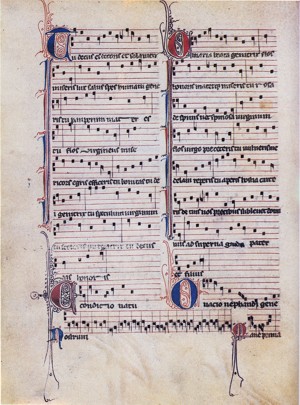 Bamberg (Ba) | 1280-1310 |
Bamberg (Ba) | 1280-1310 | collocazione: Bamberg, Staatsbibliothek [D-Bas], Lit. 115 (formerly Ed.IV.6).
descrizione: 80 parchment ff. (26·3 × 18·6 cm; written block 18·7 × 13·6 cm). Foliation: modern pencil. Structure: 10 uniform quaternions.
redazione: Same music hand for ff. 1–64v, same text hand for ff. 1–62v; different later hands for second section. Notation and layout: mostly 10 five-line staves per page; the notation is ‘Aristotelian’ (see magister Lambertus); the pages are generally divided into 2 columns for triplum and motetus, with the tenor running across the bottom of the page.
storia: Fourth quarter of the century for copying of first section, early 14th century for the second (Norwood, 1979, 1986, 1990). Provenance: Paris or Ile de France, at least for copying of first section (Norwood, 1979, 1986, 1990).
contenuto: ff.1–64v, contains 100 double motets, of which 44 are Latin, 47 French and 9 macaronic (Latin motetus, French triplum), on ff.1–62, notated in parts, plus an appx on ff. 62v–64v with 1 conductus setting of a versicle trope and 7 hocket clausulas in score. All but 1 of the compositions are for 3 voices; the other (ff.57v–58) has triplum, motetus and 2 tenors. The motets are arranged alphabetically by first letter (only) of the motetus; within each letter division the order is: Latin, macaronic, French. The second section of 2 quaternions, ff.65–80, contains the Practica artis musice by Amerus, ff.65–79; an anonymous treatise on cantus mensurabilis, f.79r–v; and 2 further motets, f.80r–v. These are all later additions. Date of music: repertory characteristic of period, c1260–90.
bibliografia:
– F. Ludwig, Die Quellen der
Motetten altesten Stils, «AMw», v (1923), 184–222,
273–315; repr. in Summa musicae medii aevi, vii (1961): 198,
220
– H. Husman, Bamberger Handschrift, in MGG1
– Apel, 302ff
– Gennrich, p.
xxv
– RISM, B/IV/1 (1966), 56ff
– G.A. Anderson (ed.), The Compositions of the Bamberg Manuscript, CMM, lxxv
(1977)
– C. Ruini (ed.), Ameri Practica Artis Musicae
(1271), CSM, xxv (1977)
– G.A. Anderson, The Notation
of the Bamberg and Las Huelgas Manuscripts, «MD», xxxii (1978),
19–67
– P. Norwood, A Study of the Provenance and
French Motets in Bamberg, Staatsbibliothek, Lit.115, diss., U. of Texas,
Austin 1979
– RISM, B/III/3 (1986), 13–14
– M.
Huglo, Le traité de Cantus Mensurabilis du manuscrit de
Bamberg, in Pax et sapientia: Studies in Text and Music of Liturgical
Tropes and Sequences in Memory of Gordon Anderson, ed. R. Jacobsson,
Stockholm 1986, 91–5
– P. Norwood, Performance
Manuscripts from the Thirteenth Century?, «College Music
Symposium», xxvi (1986), 92–6
– Everist (1989),
149–53
– P. Norwood, Evidence Concerning the
Provenance of the Bamberg Codex, «JM», viii (1990),
491–504
– Roesner 1993, lxxviii–lxxix
– R. Stephan, Bamberg Handschriften, in MGG2
facsimile: P. Aubry, Cent motets du XIIIe siècle publiés d’après le manuscrit Ed.IV.6 de Bamberg, Paris 1908 [facs., edn and commentary for ff. 1–64v]
immagine · carta 49v, mottetto Tu decus | O Maria | Nostrum
collocazione: Munich, Bayerische Staatsbibliothek [D-Mbs], Clm 14274 (formerly Mus. ms. 3232a) [Em].
descrizione: 158 paper ff., 28·5 × 21 cm. Original covers of leather over board. MS composed of 13 gatherings; 2–7 copied in black mensural notation, 1 and 8–13 in white mensural notation.
redazione: Hands of at least 14 different scribes can be detected, and 9 different watermarks have been identified. Has the nature of an anthology, containing pieces written over a period of almost 75 years (from the last decades of the 14th century to almost the middle of the 15th).
storia: Begun in Vienna, c1435, as the private anthology of Hermann Pötzlinger, who in 1443 took it to the Benedictine cloister of St Emmeram, Regensburg, where it was further expanded. Relative smallness and lack of musical or liturgical organization suggest that it was not a performance MS but a continuing collection.
contenuto: 72 mass Ordinary sections, 125 motets and liturgical pieces, c33 hymns, 8 Magnificat settings, 13 secular pieces and 21 textless pieces, by Du Fay (42), Binchois (11), Roullet (8), Dunstaple, Liebert, Grossin, Brassart, Leonel Power, Loqueville, Landini, Antonius de Civitate Austrie and others. At least 15 contrafacta have been identified.
bibliografia:
– K. Dèzes: ‘Der
Mensuralcodex des Benediktinerklosters Sancti Emmerami zu Regensburg’,
ZMw, x (1927–8), 65–105
– D. Braunschweig-Pauli:
‘Studien zum sogenannten Codex St. Emmeram’, KJb, lxvi (1982),
1–48
– I. Rumbold: ‘The Compilation and Ownership of the
“St Emmeram” Codex’, EMH, ii (1982), 161–235
facsimile:—
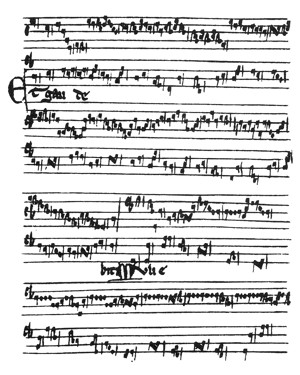 Wolfenbüttel 1 (W1) | 1240 |
Wolfenbüttel 1 (W1) | 1240 | collocazione: Wolfenbüttel, Herzog August Bibliothek [D-W], Guelf. 628 Helmst. (Heinemann catalogue 677).
descrizione: 197 ff. (21 × 15 cm); orig. 215 ff. as an older foliation (i–xxix, 30–68, 68bis, 69–214) makes clear (i–ii, vii–viii, 36–7, 51–2, 83–4, 177–84 now missing); modern foliation 1–197.
redazione: different phases of same hand throughout (Brown, 1981), or 3 different scribes (the first writing fascs.1–5, 8–10, 7 as supplement to 2; the second writing fasc.6; the third fasc.11).
notazione: square (modal) notation with many English characteristics, especially in fasc.11: brevis pairs as 2 rhombs (see fig.30), brevis between 2 longs as a rhomb, alone as clef (fasc. 6 and f. 67v [59v]), rhomb-ternaria, notes written as a long wavy line or string of rhombs (ff.146v–147 [137v–138], etc.; see Handschin, pp.116–17 and footnote).
contenuto: since Ludwig (1910) 11 fascicles are usually counted. Fasc. 1 (ff.iii–vi [1–4]): 2 organa quadrupla; 1 clausula for 4 voices. Fasc. 2 (ff.ix–xvi [5–12]): 4 organa tripla; 4 conductus for 3 voices (Benedicamus substitutes). Fasc. 3 (ff.xvii–xxiv [13–20]): 11 organa dupla for the Office, followed by 2 organa dupla for Office of St Andrew and 1 organum duplum gradual for Assumption of BVM; tropes for 1 Sanctus for 2 voices. Fasc. 4 (ff.xxv–xxix, 30–35, 38–48 [21–42]): 32 organa dupla for the Mass. Fasc. 5 (ff.49–50, 53–4 [43–6]): 33 clausulas for 2 voices. Fasc. 6 (ff.55–62 [47–54]): 70 clausulas for 2 voices, 1 conductus for 2 voices. Fasc. 7 (ff.63–8, 68bis, 69 [55–62]): 5organa tripla. Fasc. 8 (ff.70–82, 85–94 [63–85]): 18 conductus for 3 voices (for the first the third voice was never entered, the start of the last is missing because of 2 lost folios); 2 organa tripla; 1 conductus for 3 voices, 1 organum triplum; 1 clausula for 3 voices, 3 Sanctus tropes for 3 voices; 2 Agnus tropes for 3 voices. Fasc. 9 (ff.95–176 [86–167]): 4 conductus whose first part is for 3 voices, second part for 2; 3 organa dupla (Benedicamussettings); 1 conductus for 2 voices; 1 organum duplum (Benedicamus setting); 28 conductus for 2 voices; tropes for 1 Agnus for 2 voices; 49 conductus for 2 voices; tropes for 1 Agnus for 2 voices. Fasc. 10 (ff.185–92 [168–75]): 3 monophonic conductus (first lacks beginning because of missing quaternion); tropes for 6 monophonic Sanctus for week’s cycle of Lady Masses; tropes for 6 monophonic Agnus for the same; 1 explicit (by a certain Walterus) set to music (15th-century addition). Fasc. 11 (ff.193–214 [176–97]; all music for Lady Mass for two voices): tropes for 7 Kyries; 1 troped Gloria; 9 alleluias; 1 tract; 14 sequences; 8 offertories and tropes; tropes for 4 Sanctus; tropes for 3 Agnus.
storia: compiled c1240 (different sections at different times) for, and possibly in, St Andrews, Scotland (chapter of cathedral formed by canons of Augustinian priory since 1144), where its presence is attested by a 14th-century explicit(f.64 [56]). Taken from St Andrews in 1553 by Marcus Wagner (with other Scottish MSS including D-W Guelf. 499 Helmst. (Heinemann catalogue 538) from Arbroath, whose fly-leaves also contain polyphony) for Flacius Illyricus. Bought from Flacius’s widow by Count Heinrich Julius of Brunswick-Wolfenbüttel and presented to his newly founded University of Helmstedt (suppressed 1810).
bibliografia:
– F. Ludwig, Repertorium
organorum recentioris et motetorum vetustissimi stili, Halle 1910, p.
7
– J.H. Baxter: An Old St. Andrews Music Book, London, 1931/R
[facs.1]
– J. Handschin: ‘Conductus-Spicilegien’, AMw, ix
(1952), 101–19
– RISM, B/IV/1 (1966), 97–171
– Flotzinger, 220; E.H. Roesner: The Manuscript Wolfenbüttel,
Herzog-August-Bibliothek, 628 Helmstadiensis: a Study of its Origins and of its
Eleventh Fascicle (diss., New York U., 1974)
– E. Roesner: ‘The
Origins of W1’, JAMS, xxix (1976), 337–80
– J. Brown, S.
Patterson and D. Hiley: ‘Further Obsevations on W1’, Journal of the
Plainsong & Mediaeval Music Society, iv (1981), 53–80
– M.
Everist: ‘From Paris to St. Andrews: the Origins of W1’,JAMS, xliii
(1990), 1–42
– MGG2 (‘Notre Dame und
Notre-Dame-Handschriften’ [incl. facs. of f.13 (17)])
facsimile: M. Staehelin (ed.), Die mittelalterliche Musikhandschrift W1: Vollständige Reproduktion des ‘Notre Dame’-Manuskripts der Herzog August Bibliothek Wolfenbüttel Cod. Guelf. 628 Helmst., Wiesbaden, 1995 [Cremona]
immagine: carta 45r, clausula a due voci di anonimo (da Apel, Notazione)
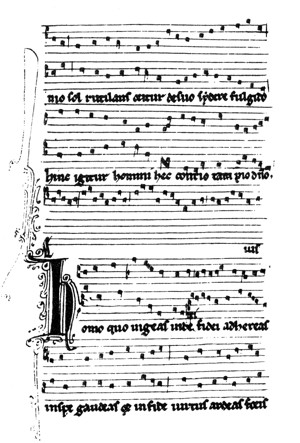 Wolfenbüttel 2 (W2) | fine xiii sec. |
Wolfenbüttel 2 (W2) | fine xiii sec. | collocazione: Wolfenbüttel, Herzog August Bibliothek [D-W], Guelf. 1099 Helmst. (Heinemann catalogue 1206).
descrizione: 255 ff. (18 × 13 cm); modern foliation 1–218, 218a, 219, 219a, 220–53; f.211 should follow f.215; the 33 gatherings are mainly quaternions, leaves are missing at the beginning and after ff. 5, 46 and 133.
redazione: 10 fascicles usually distinguished since Ludwig (1910); according to Everist (1989, p. 101), the MS in its present state is the work of 6 or 7 scribes: scribe 1 wrote fasc. 1; scribe 2 (perhaps the same as 1) wrote fascs.2, 4 and 5; scribe 3 wrote the first gathering of fasc. 3 (ff.31–38v) and fasc. 6; scribe 4 wrote the second gathering of fasc. 3 (ff.39–46v); scribe 5 wrote fasc. 7; scribe 6 wrote fasc. 8; scribe 7 wrote fascs. 9 and 10.
notazione: square (modal); steep angle of the pen for currentes; there are a few mensural ligature forms: to the 10 instances ofligatures cum opposita proprietate cited by L. Dittmer, «MD», ix (1955), p. 42, n. 8, may be added 6 on f. 8v; both ascending and descending long-breve binaria may be seen on f. 51v, line 7.
storia: probably Parisian, middle of 13th century (Everist, 1989); like D-W 628, this MS passed through the hands of Flacius Illyricus.
contenuto: Fasc. 1 (ff.1–5): end of an organum quadruplum; a clausula for 4 voices. Fasc. 2 (ff. 6–30): 12 organa tripla. Fasc. 3 (ff. 31–46): 10 conductus for 3 voices. Fasc. 4 (ff. 47–62): 15 organa duplafor the Office. Fasc. 5 (ff.63–91): 35organa dupla, of which 30 are for Mass, 1 is the Easter processional antiphon Crucifixum in carne, and 4 are Benedicamussettings. Fasc. 6 (ff. 92–122): 12 conductus for 2 voices. Fasc. 7 (ff. 123–44): ff.123–133v contain 12 motets for 3 voices (the end of the last is missing) with one Latin text for the upper voices, which are notated in score with the tenor at the end; ff.134–138v contain 5 motets for 3 voices (the start of the first is missing) with one French text, notated like the previous group; ff.138v–144v contain 9 conductus for 2 voices (the last without music, space for 2 staves per line of text). Fasc. 8 (ff. 145–92): ff. 145–155vcontain 19 Latin motets (one in 2 sections) for 2 voices, ordered alphabetically by first letter of motetus text; ff. 155v–178 contain another alphabetical series of 29 Latin motets for 2 voices, within which are found Perotinus’s monophonic Beata viscera, 2 motets for 3 voices (2 texts, successive notation), and after the second of these, which is based on the Mors melisma, texted versions of the duplum parts of 2 extracts from each of Perotinus’sorgana quadrupla Viderunt and Sederunt; ff. 178–190 contain another alphabetical series of 28 Latin motets for 2 voices, within which is a Latin motet for 3 voices (2 texts, notated successively); ff. 190–192v contain 7 Latin motets for 2 voices; between ff. 145 and 157 7 French motetus incipits are written in red ink in the margin, referring to Latin counterparts on those pages. Fasc. 9 (ff. 193–210, 212–15, 211): 22 French motets for 3 voices with 2 texts, notated successively, but including one with a Latin triplum and one with a French texted tenor; for one the triplum was never entered; also 1 French motet for 4 voices with 3 different texts. Fasc. 10 (ff. 216–18, 218a, 219, 219a, 220–253v): ff. 216–222 contain 19 French motets for 2 voices, arranged alphabetically; ff. 222–248 contain another alphabetical series of 60 French motets for 2 voices; ff. 248v–252 contain 8 French motets for 2 voices, the start of another alphabetical series; ff. 252–253v contain 3 French motets for 2 voices, possibly the end of an alphabetical series.
bibliografia:
– MGG2 (‘Notre Dame und
Notre-Dame-Handschriften’ [incl. facs. of f.16r]);
– Ludwig (1910), 157;
– F.
Gennrich:Bibliographie der ältesten französischen und lateinischen
Motetten, SMM, ii (Darmstadt, 1957);
– RISM, B/IV/1 (1966), 171–202;
– G.A.
Anderson: The Latin Compositions in Fascicules VII and VIII of the Notre Dame
Manuscript Wolfenbüttel Helmstedt 1099 (1206) (Brooklyn, NY, 1968–76)
[edn, trans. and commentary];
– Everist (1989)
facsimile: L. Dittmer, Faksimile-Ausgabe der Handschrift Wolfenbüttel 1099 Helmstadiensis (1206), Brooklyn, NY, 1960 [I-Mc]
immagine: carta 127r, mottetto di anonimo (da Apel, Notazione, facs. 55)
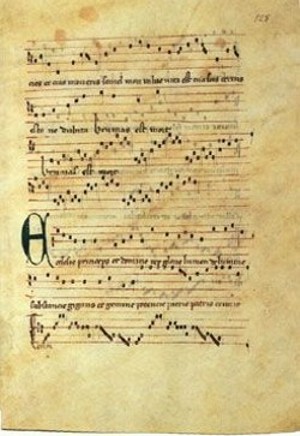 Las Huelgas (Hu) | 1300 |
Las Huelgas (Hu) | 1300 | collocazione: Burgos, Monasterio de Las Huelgas [E-BUlh].
descrizione: 170 parchment ff. (26 × 18 cm; written space varies: 23·5 × 13 cm to 15·3 × 13·2 cm). Modern ink (1906); 2 successive folios numbered 124. Structure: 19 gatherings; 1–16 (ff.1–148v) all originally quinions, but the fourth (only outer bifolio remaining) and the eighth (innermost bifolio missing) are defective. 17–19 (ff.149–168v) were originally written as 2 more quinions, but at present are bound as a quaternion, a ternion and a half, and a bifolio with 2 single folios, to be read in the order 149–52, 161, 166–7, 160, 162, 165, 153–6, 163, 164, 168; 169 is a fly-leaf.
redazione: 1 hand for the main part of the MS (ff.1–7v, 8v–152v, 157–159 first staff, 161r–v, 166–167v); a later hand entered the isolated part on f.8, and according to Anglès 11 further and later hands wrote the remaining pages from 153 on.
notazione: the red 5-line staves are distributed 6 per page for ‘score’ notation and 7–11 (ff.100v–101) for part notation; the notation is Franconian with certain idiosyncratic modifications; each of the shorter double motets is accommodated on 1 page, while the longer ones are notated as in Mo, i.e. triplum on the verso, motetus on the recto, tenor at foot of page.
storia: main part c1300 (Dittmer, MGG1, who disproved the date c1325 given by Anglès and by Reaney, RISM); later additions c1325. Provenance: MS was written for, and has remained in, the Cistercian convent of Las Huelgas.
contenuto: 45 monophonic pieces (20 sequences, 5 conductus, 10 Benedicamus tropes) and 141 polyphonic compositions, 1 of which (no.10 in Anglès edn) lacks music (therefore excluded from inventory in RISM). The comprehensive polyphonic repertory consists of conductus (including 1 Credo), Latin motets (for 2 voices, conductus motets and double motets), 1 solmization exercise, Sanctus settings, Kyrie, Gloria, Sanctus and Agnus tropes, solo portions of 3 graduals and 3 alleluias, 1 offertory trope, several Benedicamus Domino and Benedicamus tropes, and sequences. Date of music: mainly later 13th century, but including works composed in the first half of the century (Notre Dame repertory); additions: first quarter of 14th century.
bibliografia:
– J. Handschin: ‘The Summer Canon and its
Background’, MD, iii (1949), 55–94; v (1951), 65–113;
– Apel;
– Gennrich, p.xxviii;
– H. Anglès: La música de las cantigas de Santa
María del Rey Alfonso el Sabio, v/iii/1, (Barcelona, 1958),
91–8;
– MGG1 (‘Las Huelgas’, L.A. Dittmer);
– RISM, B/IV/1 (1966),
210ff;
– M. Lütolf:Die mehrstimmigen Ordinarium Missae-Sätze vom
ausgehenden 11. bis zur Wende des 13. zum 14. Jahrhundert, i (Berne, 1970),
262–83;
– G.A. Anderson: ‘The Notation of the Bamberg and Las Huelgas
Manuscripts’, MD, xxxii (1978), 19–67;
– D. Vega Cernuda: ‘El
códice de Las Huelgas: estudio de su técnica
polifónica’, RdMc, i (1978), 9–60;
– G.A. Anderson, ed.:The Las
Huelgas Manuscript, CMM, lxxix (1982);
– Roesner (1993), lxxix–lxxx; MGG2
(‘Las Huelgas’, M. Gómez)
facsimile: H. Anglès: El còdex musical de Las Huelgas (Barcelona, 1931/R) [facs., edn and commentary]
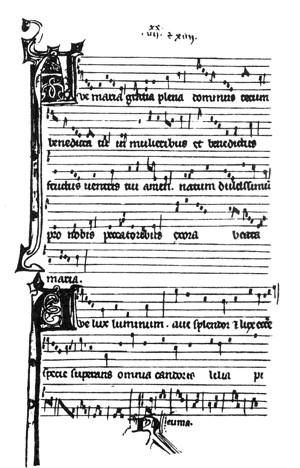 Montpellier H196 (Mo) | 1270-80 |
Montpellier H196 (Mo) | 1270-80 | collocazione:Montpellier, Bibliothèque Inter-Universitaire, Section Médecine [F-MOf], H196 [Mo].
descrizione:Originally 402 parchment ff. (19·2 × 13·6 cm, written block 12·8 × 7·7 cm), of which 400 survive, a bifolio with ff.303 and 308 having been lost before gatherings were made. Foliation: 4 series, all of which omit the first 5 folios containing the original table of contents up to f. 333, including ff. 303 and 308: (1) original ink Roman numerals ff. 1–333, including 303 and 308; ff. 18 and 19 erroneously numbered 19, 18; (2) ink Arabic numerals 1–48 on ff. 350–97, many of which have been cut away; (3) ink Arabic numerals 334–97 continuing and completing original foliation; (4) pencil Arabic numerals 1–333 not allowing for missing ff. 303 and 308, hence ending on f.335.
fascicoli: all gatherings are quaternions except the first, a bifolio, the second, a ternion, and ff. 239–45 (one leaf cut away before foliation). 8 fascs.: ff. 1–22, 23–62, 63–86, 87–110, 111–230, 231–69, 270–349, 350–97, representing an original ‘old corpus’ of fascs. 2–6 and 2 major layers of additions, (a) fascs. 1 and 7, along with additions to fascs.3 and 5, and (b) fasc. 8 along with additions to fasc.7. The additions carefully reproduce critical features of the original format.
redazione: several; precise number of text and music hands not determined (Rokseth); Jacobsthal distinguished 14 text hands, while Wolinski finds 11. Most significantly, all of fascs. 2–6, with the exception of later appx to 3 and 5, are the work of one text scribe and notator; fasc.1 has a single notator; the main section of fasc. 7 is the work of a single scribe and notator; and fasc. 8 is the work of a single scribe and notator.
notazione: 6–8 red 5-line staves per page; the notation of the ‘old corpus’ is ‘pre-Franconian’ (generally modal ligatures, rhythmically differentiated single notes, undifferentiated rests), while that of fasc.8 is Franconian and that of fasc. 7 nearly so. The layout of the motet voices differs from that in the older sources. The 4 voices of the triple motets (fasc.2): 2 sets of double columns on facing pages. Double motets of the old corpus: triplum on verso, motetus on recto, tenor across bottom of both pages. The upper voices of the double motets of fascs.7 and 8 are written in 2 not necessarily equal columns per page, a system presumably invented because of the uneven text distribution in Petronian and similar motets, though often the greater amount of triplum text also caused the end of that voice to be written across the entire page. Only in fasc.8, however, are the voices (of all but 4 motets) laid out so that all reach the bottom of a page simultaneously. Performance by reading, rather than from memory, here becomes a possibility, as a result of the innovations of Franconian notation.
datazione: fascs.2–6, 1270s (Rosketh and RISM, c1280); fascs.1 and 7, plus the additions to 3 and 5, very end of 13th century (Branner: late 13th century, Everist: 1280s); fasc.8, very early years of the 14th century (Branner and Everist: c1300). As a controversial alternative to the picture of a manuscript compiled in discrete stages of activity a decade or more apart, Wolinski posits a single campaign of copying fascs.1–7 as an entity in the 1260s or 1270s, with fasc.8 perhaps also as early as the 1270s; not widely accepted, her theory has radical implications for the development of the motet, musical notation and music theory in the second half of the 13th century (Wolinski, 1992, pp.299–301).
storia: Provenance: Paris. Nothing is known of its ownership before the 1570s or 1580s (Everist, 1989, pp.115–18; Wolinski, 1992, pp.287–8), when it was in the possession of Estienne Tabourot of Dijon.
contenuto: There are 336 polyphonic compositions, of which 8 lack music (therefore not included in RISM inventory), 5 are duplications and 3 are contrafacta; several survive incomplete. Mo (F-MOf H196) is the largest medieval motet MS extant; all compositions but those in the first fascicle (nos.1–10) and the first compositions of the fifth and eighth fascicles (nos.64 and 286) are motets. Nos. 1 and 286 are conductus settings of a versicle trope, nos. 2, 3 and 64 are 2 modal versions of a hocket for 3 voices with a texted quadruplum added to nos. 2 and 3, no.4 is a Benedicamus in conductus style, no. 5 is a hocket and nos. 6–10 are organa, at least 2 of them by Perotinus. Each motet fascicle is dedicated principally to one genre: in the ‘old corpus’ fasc. 2: 16 French and 1 Latin triple motets; fasc. 3: 11 macaronic motets (Latin motetus, French triplum); fasc. 4: 22 Latin double motets; fasc. 5: 100 French double motets (plus 1 Provençal, 1 French-Provençal and 1 French-Latin); fasc. 6: 75 French motets for 2 voices. The appx to fasc. 3: 4 motets for 2 voices (2 Latin, 2 French); the appx to fasc. 5: 1 macaronic motet (French-Latin). Fasc. 7: 39 double motets (26 French, 7 Latin, 3 Latin-French, 3 French-Latin), at least 2 of them by Petrus de Cruce; appx to fasc. 7: (a) 8 French double motets; (b) 1 Latin double motet, 1 Latin motet for 2 voices, 1 French-Latin double motet; fasc. 8: 42 double motets (21 French, 16 Latin, 4 Latin-French, 1 French-Latin). Date of music: the whole of the 13th century.
bibliografia:
– G. Jacobsthal: ‘Die Texte der
Liederhandschrift von Montpellier H.196’, Zeitschrift für romanische
Philologie, iii (1879), 526–56;
iv (1880), 35–64, 278–317;
– O.
Koller: ‘Der Liederkodex von Montpellier’,VMw, iv (1888),
1–82
– F. Ludwig: ‘Die 50 Beispiele Coussemaker’s aus der
Handschrift von Montpellier’, SIMG, v (1903–4), 177–224
– P.
Aubry: Recherches sur les ‘Tenors’ français (Paris,
1907)
– P. Aubry and A. Gastoué: Recherches sur les ‘Tenors’
latins (Paris, 1907); Ludwig (1910), 345–408, 421ff; Ludwig (1923),
193ff
– Besseler (1926), 137ff
– G. Kuhlmann: Die zweistimmigen
französischen Motetten des Kodex Montpellier, ii (Würzburg, 1938)
[edn of fasc.6]
– J. Handschin: ‘The Summer Canon and its Background,
II’, MD, iii (1949), 55–94; v (1951), 65–113
– Apel, 284ff,
315ff
– L. Dittmer: ‘The Ligatures of the Montpellier Manuscript’,
MD, ix (1955), 35–55
– Gennrich, pp.
xxx–xxxii
– MGG1 (‘Montpellier-Handschriften’, G.
Reaney)
– RISM, B/IV/1 (1966), 272–369
– F. Mathiassen: The Style of the
Early Motet (Copenhagen, 1966)
– E. Apfel: Anlage und Struktur der Motetten im
Codex Montpellier: Annales Universitatis Saraviensis (Heidelberg, 1970)
– R.
Branner: Manuscript Painting in Paris during the Reign of St Louis: a Study of
Styles (Berkeley, 1977)
– H. Tischler, ed.: The Montpellier Codex (Madison,
WI, 1978–85), iv
– M. Wolinski: The Montpellier Codex: its Compilation,
Notation and Implications for the Chronology of the Thirteenth-Century Motet
(diss., Brandeis U., 1988)
– Everist (1989), 110–34; M. Wolinski:
‘The Compilation of the Montpellier Codex’, EMH, xi (1992),
263–301
– Roesner (1993), lxxvii–lxxviii
– Everist (1994),
8–12; MGG2 (‘Montpellier Handschriften’, D. Hiley)
facsimile: Y. Rokseth, Polyphonies du XIIIe siècle: le manuscrit H196 de la Faculté de médecine de Montpellier, Paris, 1935–9 [facs., edn and commentary] [Cremona]
immagine: carta 94r (da Apel)
collocazione: Paris, Bibliothèque de l'Arsenal [F-Pn], 5198 (formerly B.L.F. 63).
descrizione: 211 parchment leaves, 32 × 22 cm. Foliation and pagination: original pencil foliation i–xxxvii, corresponds to index on p. 420; modern ink pagination 1–420 (with 70 followed by 70bis and 70ter), disregards lacuna between gatherings 21 and 22; scholars use the pagination. Structure: 25 quaternions, 1 binion and 1 gathering of 7 leaves; gathering signatures indicate 1 gathering missing between pp. 332 and 333; p. 420 has a medieval index of 64 incipits of songs on the first 2 gatherings. Layout: 2 columns, 34 lines per column, prose format.
redazione: Decoration: 2 large polychrome initials begin each main fascicle (Thibaut IV holding a fiddle on p.1 and p.303); gold leaf initials with blue, pink and white paint, in a style similar (but not identical) to that of N, probably from Picardy or Artois; red or blue lettrines mark interior stanzas; circled attributive red rubrics in margins on pp.1–302 are similar to those in N. Text scribes: one scribe throughout, possibly same as that for N. Notation: one hand throughout, square notation, 4-line red staves; music entered before decoration and rubrics.
storia: Date and provenance: 1270s, Picardy or Artois; belonged to Marie d'Albret (p.1); later belonged to Marquis René Antoine de Paulmy, who made it part of his library at l'Arsenal, opened to scholars in 1756.
contenuto: pp. 1–302: 342 attributed songs, at first arranged by author, then more randomly entered; pp. 302–420: 140 unattributed songs; contents related to N, P, X and L. Melodies: altogether 481 complete melodies and 1 incomplete: Thibaut IV (59), Gace Brulé (46), Perrin d'Angicourt (21), Chastelain de Couci (16), Blondel de Nesle (16), Gillebert de Berneville (14), Richart de Semilli (10), Moniot de Paris (9), Gautier de Dargies (8), Moniot d'Arras (7), Thibaut de Blason (6), etc.
bibliografia:
– Raynaud, i, 54–73
– P. Aubry and A. Jeanroy, eds.: Le chansonnier de l'Arsenal (Paris,
1909–10) [facs. of pp.1–384, transcrs. of pp.1–184]
– Ludwig,
i/1, 336–7
– H. Spanke, ed.: Eine altfranzösische Liedersammlung:
der anonyme Teil der Liederhandschriften KNPX (Halle, 1925) [edn of anon.
poems, 42 melodies]
– H. Orenstein: Die Refrainformen im Chansonnier de
l'Arsenal (Brooklyn, NY, 1970)
– Huot, 48–54
– Everist, 187–97
facsimile: Aubry–Jeanroy
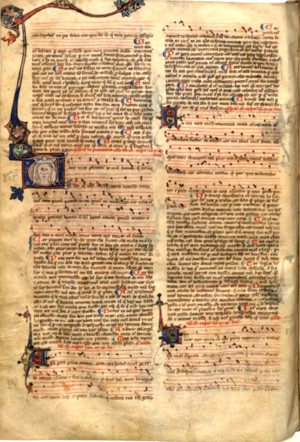 Chansonnier d'Urfé (*R) | ca.
1300 |
Chansonnier d'Urfé (*R) | ca.
1300 | collocazione: Paris, Bibliothèque Nationale de France [F-Pn], fr. 22543 (formerly 2701, La Vallière 14)
descrizione: 4 + 147 parchment leaves, 43 × 30 cm. Foliations: medieval foliation i–cxlviii beginning after the index; modern pencil foliation A–C on the last three leaves of the index and 1–148 (most modern studies use this foliation, even though it ignores the lacuna of ff.73–4); another modern foliation 1–143 begins on f.5, where the lyric songs begin.Structure: original ff.73–4 missing (inner bifolio of gathering 9); medieval index on binion at beginning, then 13 quinternions, 1 quaternion (ff.61–8), and an irregular gathering of 7 leaves followed by a binion. Layout: for songs, 2 columns, 80 lines per column in prose format; for non-lyric works, 2–7 columns.
redazione: Decoration: idiosyncratic initial decoration of uniform conception and varying levels of elaboration, including red and blue calligraphic initials and larger historiated initials at the beginnings of several composer collections; alternating red and blue strophe caputs; red rubrics with composers' names; rubrics in section of songs by Guiraut Riquier (ff.104v–111v) also give genre and date. Text scribe: one hand throughout except for a few additions from the 14th century and later. Notation: generally 4-line red staves above first stanzas, entered in the first gathering only when melodies available, thereafter for every song; large number of empty staves and somewhat random diffusion of melodies throughout the codex, except in the Guiraut Riquier section; square notation, possibly several notation hands, including a few with primitive mensural values (longs and breves) which are not in consistent modal patterns; music added after text, rubrics and decorative elements.
storia: Date and provenance: c1300, Languedoc; rubric on f.141v beginning Ensenhamen del Guarso by Cavalier Lunel de Monteg dated 1326, in later hand; owned by Jeanne Camus, Marquise de la Rochefoucauld d'Urfé, by about 1737; sold to Louis César de La Beaume le Blanc, Duc de La Vallière, sometime after 1766, and then by his heirs to the Bibliothèque du Roi in 1784.
contenuto: ff.1–4:vidas and razos; ff.5–111v: 925 lyric songs, 160 with melodies, includes libellus of Guiraut Riquier on ff.104v–110; ff.112v–121: coblas and non-lyric letters without staves; ff.121v–142v: Tezaur of Peire de Corbian, ensenhamens and other didactic works, letters of Guiraut Riquier, and 4 lyric works without staves; ff.143–145v: 14 lyric songs with empty staves; ff.146v–148v:ensenhamens, letters, didactic works. Melodies: Guiraut Riquier (48), Raimon de Miraval (22), Bernart de Ventadorn (13), Folquet de Marseille (10), Gaucelm Faidit (9), Peire Vidal (9), Berenguier de Palazol (8), Raimbaut de Vaqueiras (8), Jaufre Rudel (4), etc.
bibliografia:
– Beck, 8–14 [with list of melodies]
– E.
Aubrey: A Study of the Origins, History, and Notation of the Troubador
Chansonnier Paris, Bibliothèque Nationale, f. fr. 22543 (diss., U. of
Maryland, 1982) [with list of contents]
– E. Aubrey: ‘The Transmission of
Troubadour Melodies: the Testimony of Paris, Bibliothèque Nationale, f.
fr. 22543’, Text, iii (1987), 211–50
– G. Brunel-Lobrichon:
‘L'iconographie du chansonnier provençal R: essai
d'interprétation’, Lyrique romane médiévale: la
tradition des chansonniers: Liège 1989, 245–72
– A. Tavera:
‘La table du chansonnier d'Urfé’, Cultura Neolatina, lii
(1992), 23–138
– Aubrey, 39, 46–8
facsimile: Parz. on line in Mandragore
immagine: Foglio 104v.
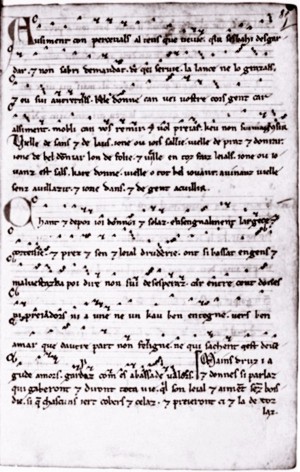 Chansonnier Saint Germain (°U *X) | 1250
|
Chansonnier Saint Germain (°U *X) | 1250
| collocazione: Paris, Bibliothèque Nationale de France [F-Pn], fr. 20050 (formerly St Germain fr. 1989).
descrizione: 3 + 168 parchment leaves, 18 × 12 cm, plus 2 partial leaves tipped in later (ff. 120 and 151). Foliations: original i–clxviii (lxxxxi is missing), beginning on the leaf after the index, in the side margin on the verso, keyed to the index; later black pen 1–173 begins with the index and ignores the lacuna; the tipped in partial leaves (ff. 120 and 151) are not included in the original foliation; scholars use the modern Arabic foliation. Structure: 19 quaternions, 2 bifolios, 1 ternion with a leaf tipped in, and 1 irregular gathering of 4 leaves at the end; medieval index at the beginning is on 3 leaves, a bifolio plus 1 leaf glued in; 1 leaf is missing between ff. 93 and 94 (according to the original foliation), but no text seems to be missing. Layout: single column; varying number of lines per column: 26 (ff. 4–91v), 25 (ff. 94–109) and 20–23 (ff. 110 to the end); prose format.
redazione: Decoration: 1 painted initial begins f. 4; elsewhere red initials begin each song, all added after the music except on ff. 22v–23; ff. 4–92, interior stanzas are highlighted by red marks on the black ink letters; ff. 94–152, interior stanzas begin with red ink lettrines; modern attributive rubrics in black ink. Text scribes: ff. 4–91v, 1 scribe; several other hands in the rest of the codex, including that of the main scribe. Notation: 4-line red staves on ff. 4–91v; space allowed for staves but none drawn in on ff. 92r–v, 110–152 and 154v–161; elsewhere no space allowed for music; 1 main music hand, with a few melodies added here and there by at least 2 other scribes, all using Messine neumes; 1 melody added on f. 170v in square notation, possibly by a modern hand; gatherings 5 and 10 have empty staves, and gatherings 4, 5 and 11 have mostly empty staves.
storia: Date and provenance: after 1240, probably by 1250, Lorraine; Everist (1989) argues on paleographical grounds that it was produced as early as c1225, but it contains songs by several composers who could not have worked earlier than the 1240s; has been conjectured that the MS was accumulated over several decades, possibly by a jongleur, but the comprehensive index gives original foliation numbers and uses the same decorative initial highlights as in the texts, and gathering cues throughout the codex seem to be contemporary with the main text hand (Tyssens; Aubrey, p. 35); the MS belonged to Henri-Charles du Cambout, duke of Coislin and bishop of Metz, who may have inherited it with the collection of his grandfather, chancellor Pierre Séguier (d 1672); Coislin placed his MS collection in the care of the abbey of St-Germain-des-Prés in 1720; the abbey retained possession after Coislin's death in 1732, and the collection entered the Bibliothèque Nationale in 1795.
contenuto: 304 French chansons, pastourelles and chansons de toile, 91 with music (not counting the late addition on f. 170v); 28 Occitan cansos (ff. 81–91 and 148v–151) copied without being segregated, 22 with melodies. Melodies: no attributions, but authenticated by concordances: Jaufre Rudel (1), Rigaut de Berbezilh (2), Bernart de Ventadorn (2), Gaucelm Faidit (7), Peire Vidal (2), Gace Brulé (16), Blondel de Nesle (3), Chastelain de Couci (10), etc.
bibliografia:
– Raynaud, i, 172–83
– P. Meyer and G.
Raynaud: Le chansonnier français de Saint-Germain-des-Prés
(Paris, 1892/R) [facs.]
– Ludwig, i/1, 337
– I. Parker: ‘Notes on the Chansonnier
Saint-Germain-des-Prés’, ML, lx (1979), 261–80
– Huot,
52–3
– Everist, 199–200
– M. Tyssens: ‘Les copistes du
chansonnier français U’, Lyrique romane médiévale: la
tradition des chansonniers: Liège 1989, 379–98
– R. Lug: Der
Chansonnier de Saint-Germain-des-Prés (Paris, BN fr.20050): Edition
seiner Melodien mit Analysen zur ‘vormodalen’ Notation des 13.
Jahrhunderts und einer Transkriptionsgeschichte des europäischen
Minnesangs (Frankfurt, 1995)
– Aubrey, 34–8
immagine: Foglio 85r.
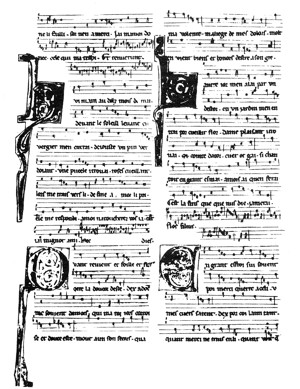 Manuscrit du Roi (°M *W) | 1265 |
Manuscrit du Roi (°M *W) | 1265 | collocazione: Paris, Bibliothèque Nationale de France [F-Pn] , fr. 844 (formerly 7222; Mazarine 96).
descrizione: 2 collections bound together with gatherings somewhat out of order, 32 × 22 cm. Foliations: modern red ink foliation B–E, 1–215, added presumably when the MS was bound with gatherings out of order and leaves missing, and after the miniatures were cut out; the Becks' facsimile assigns a new foliation to the restored codex; scholars use the foliation as the actual leaves rather than the Becks'.
sezioni: (i) the larger fascicle, M, now 4 + 213 parchment leaves (ff. B–E, 1 to the left column of 13, 14–58 and 79–215), which originally comprised 15 quaternions and 9 irregular gatherings; ff. B–E have incipits of this collection without folio numbers, written by the same scribe who entered the texts and decorated with the same lettrines as in the main MS; (ii) a smaller fascicle of songs by Thibaut IV, labelled Mt in the Becks' facsimile, begins in the right column of f. 13 immediately following the conclusion in the left column of a small group of songs also by Thibaut; this fascicle comprises 18 parchment leaves (right column of f. 13, ff. 13v and 59–78, comprising 2 quaternions and 1 binion); the index does not include incipits of Mt.
osservazioni: Present state of the large codex is poor, missing 18 of its original leaves and with many remaining leaves mutilated by excision of miniatures; mutilation occurred before the MS was described by P. Paris in 1845; many marginalia in a modern hand giving text (incipits, rubrics, etc.) lost to lacunae; Mt is undamaged. The larger codex seems to be a MS in progress, with many spaces left empty presumably for addition of more stanzas; during the late 13th century and the 14th other scribes, most using mensural notation, filled some of these spaces with 33 other works, including untextedestampies(ff.103v–104v) and songs in Old French and Occitan; the Becks' facsimile restores the original order of the gatherings and reconstructs the contents of the lacunae; added leaves at the beginning (ff. A and 216–21) have lists of authors and incipits.
redazione: textblock of M is ruled in pencil and stanzas
begin at left margin; textblock of Mt is ruled in dry point and stanzas are
laid out in prose format; both collections have 2 columns with 41 lines per
column.
Decoration: M has historiated initials on first song of
groups of authors' works (15 of which survived the excisions), initials painted
with blue, pink, gold leaf, white tracery and black outlines at beginnings of
the remaining songs, alternating blue/red and gold/blue calligraphic lettrines
marking interior stanzas, line endings of gold, red and blue fill lines at ends
of stanzas, and red rubrics with authors' names, almost all entered before the
music was added except in the motet fascicle, where the decoration was entered
last; Mt has no historiated initials, but painted initials beginning each song
are in same style as in M, probably done in the same atelier; lettrines use the
same colours and style as in M but are much less elaborate; decoration in Mt
was added after the music notation.. Text scribes: 1 text scribe for M
and another for Mt.
notazione: 1 scribe for Mt, square notation; 2 scribes for the songs and motets in M, 1 main hand and another less careful hand for at least 33 melodies; 4-line red staves, square notation throughout except for three melodies in mensural notation entered by the second scribe of M and by the scribes of many of the later entries; tenors of the motets are more or less modal.
storia: after 1253, probably 1260s or 1270s, Artois (possibly Arras); came to Bibliothèque du Roi in 1668 from Bibliothèque Mazarine; the Becks suggested the MS was copied for Charles d'Anjou, count of Provence from 1245, but this is unsubstantiated.
contenuto M: M originally contained 428 Old French songs; in its current state it preserves in complete or fragmentary condition. ff. 1–185: 404 songs by trouvères, 365 with melodies, grouped by author beginning with ‘li princes’ and proceeding roughly in descending order of nobility; ff. 188–204: 61 songs by troubadours, 51 with melodies; ff. 205–210: originally 45 French two-voice motets and 3 three-voice motets (13 tenors without music); ff. 212–214: 1 Old French and 2 French-Occitan lais;
contenuto Mt: has 60 songs by Thibaut IV, 56 with complete melodies and 2 with unfinished melodies; contents are closely related to T, including the motets; among the later additions are 9 monophonic ‘estampies royals’ (the first a fragment) in mensural notation on ff.103v–104v.
autori: Gace Brulé (42), Guillaume Le Vinier (27), Gautier de Dargies (19), Blondel de Nesle (21), Audefroi le Bastart (16), Guiot de Dijon (14), Jehan Erart (10), Gillebert de Berneville (14), Chastelain de Couci (11), Colart le Boutellier (12), Moniot d'Arras (13), Conon de Béthune (8), Raoul de Ferrières (9), Bernart de Ventadorn (8), Folquet de Marseille (4), Rigaut de Berbezilh (3), Gaucelm Faidit (3), Comtessa de Dia (1), etc.
bibliografia:
– P. Paris:Les manuscrits
françois de la Bibliothèque du Roi, vi (Paris, 1845),
450–3
– Raynaud, i, 75–8 [index of Mt in its current state]
and 78–94 [index of Min its current state]
– Ludwig 1910, i/1,
285–305 and i/2, 621–6
– H. Spanke: ‘Der Chansonnier
du Roi’, Romanische Forschungen, lvii (1943), 38–104
– RISM
B/IV/1, 374–9; Huot, 181–7
– J.A. Peraino: New Music,
Notions of Genre, and the ‘Manuscrit du Roi’ circa 1300 (diss., U. of
California, Berkeley, 1995)
– Aubrey, 37–43
– J.D.
Haines: The Musicography of the ‘Manuscrit du Roi’ (diss., U. of
Toronto, 1998)
facsimile: J. and L. Beck, Le manuscrit du roi, London and Philadelphia, 1938 (Corpus cantilenarum medii aevi I.2)
immagine: carta 206v (da Apel)
collocazione: London, British Library [GB-Lbl], Add. 29987.
descrizione: 88 parchment ff. (26 × 19·5 cm) survive of an original MS of no fewer than 185ff.; 6 flyleaves at front and 2 at back. Foliation: 98–185 (original, palimpsest), renumbered 1–85 (17th or 18th century); 2–88 (dating from 1876). Structure: 11 gatherings, each of 8 folios.
redazione: carelessly written MS, with 1 principal hand and several additional hands (2 of which also copied I-Fc D.1175 and Fsl 2211; see Long, Nádas); at some stage a separate hand corrupted many musical readings by adding nonsensical rests and modifying the rhythms (see Gozzi).
storia: main corpus variously dated as late 14th to early 15th century (Reaney), very early 15th century (Fischer) and c1425 (Pirrotta); southern Tuscany or Umbria (Fischer) or possibly Florence (Reaney, Di Bacco); the MS may have been mutilated at the beginning of the 16th century; the surviving section bears a coat of arms of the Medici family; it was in the hands of Carlo Tomasini Strozzi in the 17th century, then in a private library in Florence, and reached the British Museum in 1876.
contenuto: 119 pieces: 35 or 36 madrigals, 45 ballatas, 8 cacce, 15 estampies, 7 liturgical works (some monophonic), 3 virelais, and other forms. Date of music: 1340–1400 (except no. 118, which is much later). Composers: Landini (29), Niccolò da Perugia (12 or 13), Jacopo da Bologna (7), Bartolino da Padova (5), Giovanni da Cascia (5) and others.
bibliografia:
– J. ten Bokum: De dansen van het
Trecento (Utrecht, 1967) [dances];
– see also individual composers
Wolf, 268;
– G. Reaney: ‘The Manuscript London, British Museum,
Additional 29987 (Lo)’, MD, xii (1958), 67–91;
– RISM,
B/IV/4 (1972), 631–53;
– Long (1981), 171;
– C.C.
Garforth: The Lo Manuscript (diss., Northwestern U., 1983);
– Nádas (1985), 304;
– G. Di Bacco: ‘Alcune nuove
osservazioni sul codice di Londra (British Library, MS Additional 29987)’,
Studi musicali, xx (1991), 181–234;
– M. Gozzi: ‘Alcune
postille sul codice Add. 29987 della British Library’, Studi musicali,
xxii (1993), 249–77;
– G. Carsaniga: ‘An Additional Look at
London Additional 29987’, MD, xlviii (1994), 263–97.
facsimile: MSD, xiii (1965) [facs., recto and verso sides reversed]
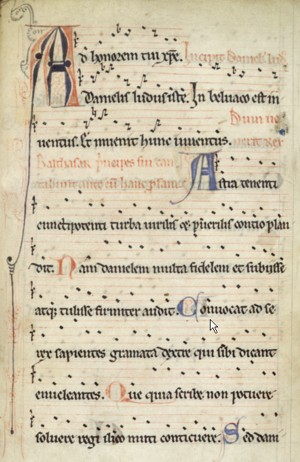 Egerton 2615 (LoA) | 1230
Egerton 2615 (LoA) | 1230collocazione: London, British Library [GB-Lbl], Eg. 2615 [LoA].
descrizione: 111 ff. (21,8 × 13,3 cm); British Museum foliation (1894) 1–78, then an unnumbered folio called since Ludwig (1910) 78bis, then 79–110.
fascicoli: mainly quaternions; ff. 73–78bis is a 7-leaf gathering (f. 75 is the single); a gap in the series of original gathering signatures reveals that a gathering is missing after f. 40; last gathering signature f. 72v; the gathering ending f. 94 ends in the middle of a piece. Everist has shown that the parchment of ff. 79–94 was ruled identically to part of D-W 1099 and is therefore from Paris.
redazione: first scribe and notator wrote ff. 1–68, 95–110; another scribe and notator ff. 79–94; a different notator wrote polyphony for the first scribe (upper voices of Orientis partibus, ff. 43–44v, and ff.69–72v of the polyphonic supplement); further additions in other hands ff. 73–8; same coloured initials for both the first section and ff. 79–94.
notazione: the pen of the first notator is tilted in typical Picardian style (cf F-Psg 117, 13th-century antiphoner from St Michel, Beauvais) so that all puncta are rhombs; virga has tail to left; thus climacus is 3 rhombs with descending tail to the left of the first (‘Rautenternaria’); rhomboid forms are also used by other hands, but not by the notator of ff.79–94, who, however, does use rhomb-ternaria; staves of 4 or 5 red lines (3 for the lections at end of MS, green for middle voice of Orientis partibus); 10 staves per page to f. 69r, 12 thereafter.
storia: the «Laudes regiae» of the Mass name Pope Gregory IX (1227–41); the Daniel play is announced as having been written in Beauvais (for other evidence of the tradition of an elaborate Circumcision Office at Beauvais, see Hughes, 1966); MS in Beauvais until at least 1775; in 1848 it was in Padua; purchased by British Museum in 1883.
contenuto: ff. 1–68v Office and Mass for New Year’s Day (Feast of Circumcision, ‘Feast of Fools’), including plainsong for first Vespers, Procession to the Rood, Compline, Matins, Lauds (probably a Procession is missing after this), Mass, Sext, None, second Vespers; there is rich provision of tropes (especially for the responsories) and conductus (e.g. each of the last eight lessons of Matins is preceded by a conductus); polyphony (‘cum organo’) is rubricated 11 times, and a set of antiphons at first Vespers is directed to be begun ‘cum falseto’. ff. 69–78v settings for 3 voices of 3 pieces mentioned in the foregoing first Vespers and 2 mentioned in the Procession; these are an alleluia verse, with a text for the 2 upper voices; a versus; a troped responsory (prelude and median tropes set for 2 voices, prosula set for 3 voices); another troped responsory (without text); Serena virginum (melismatic tenor and 2 upper voices all in score, words not entered). F. 76v also contains a hymn setting for 3 voices, and on ff. 77v–78 is another setting of the median trope above, this time for 3 voices; the rest of these added leaves are blank. ff. 79–94 Perotinus’s organum quadruplum Viderunt, followed by 11 pieces for 3 voices; these are a responsory, the alleluia verse and versus on ff. 69–72v above, 5 conductus, 2 motets where all 3 parts are written in score with text for the upper voices under the tenor (one is Serena virginum), and the troped responsory on ff. 74r–v above. ff. 95–108r the Ludus Danielis. ff. 108v–110r 2 lections.
bibliografia:
– Ludwig 1910, 229
– D.G. Hughes: ‘Liturgical Polyphony at Beauvais in the Thirteenth
Century’, Speculum, xxxiv (1959), 184–200 [facs. of f.73]
– RISM, B/IV/1 (1966), 501ff
– D.G. Hughes: ‘The Sources of
Christus manens’, Aspects of Medieval and Renaissance Music: a Birthday
Offering to Gustave Reese, ed. J. LaRue and others (New York, 1966/R),
423–34
– W. Arlt: Ein Festoffizium des Mittelalters aus
Beauvais in seiner liturgischen und musikalischen Bedeutung (Cologne, 1970)
[complete edn of Circumcision Office, and 5 polyphonic
pieces]
– J. Stenzl: Die vierzig Clausulae der Handschrift
Paris Bibliothèque Nationale Latin 15139 (Berne, 1970), pls. 6 and 7
[facs. of ff. 9v and 74v]
– Anderson, pl. 2 [facs. of f.
73v]
– M. Everist (ed.), French 13th-Century Polyphony in the
British Library: a Facsimile Edition of the Manuscripts Additional 30091 and
Egerton 2615 (folios 79–94v) (London, 1988)
facsimile · [delle sole cc. 9v, 73r-74v, 79–94v (v. bibl.)]
immagine · carta 95r, prima pagina del Ludus Danielis
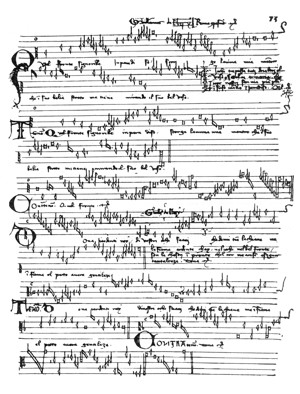 Oxford, Can. misc. 213 | 1450 |
Oxford, Can. misc. 213 | 1450 | collocazione: Oxford, Bodleian Library [GB-Ob]
descrizione: paper ff., 29·8 × 21·5 cm. 10 gatherings, preceded by an original index.
redazione: Gatherings 5–8 the oldest, and include a few pieces copied in black notation; gatherings 9–10 slightly later; 1–4 copied last. 9 works have dates, ranging from 1422 to 1436; it is not clear whether these indicate the date of copying. Probably copied in Venice, in third and fourth decades of the century.
contenuto: 325 pieces made up of 187 rondeaux, 10 virelais, 38 ballades, 3 chansons, 25 ballatas, 21 mass Ordinary sections, 37 motets, 1 Magnificatand 3 laude, by Du Fay (52), Binchois (29), Hugo de Lantins (20), Arnold de Lantins (20), Vide (7), Cordier (7), Fontaine (7), Brollo (6), Cesaris (6), Loqueville (6), Grenon (5), Guillaume Legrant (5), Ciconia (4) and others. Some 60 pieces remain anonymous; some 220 are unica.
sezioni: The oldest gatherings (5–8) contain mostly French secular pieces, some dating back to the late 14th century; gatherings 9–10 have many pieces by Du Fay and the Lantins; the latest gatherings (1–4) contain most of the motets and mass Ordinary sections, with many chansons.
bibliografia:
– J.F.R. and C. Stainer, Dufay
and his Contemporaries, London, 1898
– C. van den Borren (ed.), Polyphonia Sacra: a Continental Miscellany of the Fifteenth
Century, Burnham, Bucks., 1932, rist. 1963
– G. Reaney, The Manuscript Oxford, Bodleian Library, Canonici Misc. 213,
«Musica disciplina», ix (1955), 73–104 [inventory]
– Schoop 1971
facsimile: D. Fallows, Oxford, Bodleian Library MS. Canon. misc. 213, Chicago, 1995 [I-Mc, anche una copia ms di Benvenuto Disertori (Disertori M.27.11)]
immagine: carta 73r · due brani profani in italiano di Dufay (da Apel, Notazione, facs. 23)
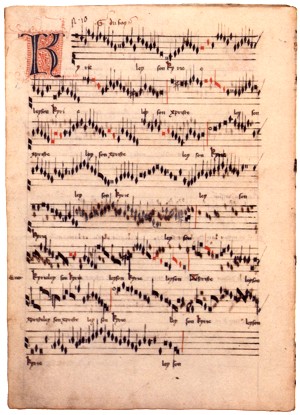 Bologna, Q.15 | ca. 1420-35 |
Bologna, Q.15 | ca. 1420-35 | collocazione: Bologna, Civico museo bibliografico musicale (già Biblioteca del Conservatorio e Liceo musicale G. B. Martini) [I-Bc]
descrizione: 342 ff., mostly of paper but with some outer or middle bifolios of gatherings of parchment, 28 × 20 cm. An old foliation system in Roman numerals skips gatherings 11–12 and 20; another numbering system attempts to number the pieces, but is inaccurate and incomplete; a modern foliation, 1–342, omits one folio but uses the same number for two others. Rebound and restored, with new covers; f.1 has an incomplete original index.
redazione: One scribe copied ff.1–250 and 341–2; possibly two other scribes, contemporaneous with the main scribe, completed the copying. MS copied in black mensural notation. Copied probably at Padua: an original layer of c1420–25 was partly reconstructed and expanded, c1430–35, with much new material.
storia: Padre Martini acquired it in 1757 from Piacenza.
contenuto: 4 masses, 122 mass Ordinary sections, 118 motets, 24 hymns, 9 Magnificat settings, 19 French secular pieces, 11 laude, by Du Fay (69), Johannes de Lymburgia (42), Ciconia (13), Arnold de Lantins (17), Salinis (8), Antonius Romanus (6), Brassart (8), Feragut (6), Franchois (7), Loqueville (6), Zacara da Teramo (11), Antonius de Civitate Austrie (5), Binchois (5), Dunstaple (4) and others. 33 pieces remain anonymous.
sezioni: Gatherings 1–3 and 13–18 contain complete and composite mass Ordinary cycles, 3–10 contain Gloria-Credo pairs, 11–12 are added gatherings with mass Ordinary sections, 18–27 contain motets, 27–8 have hymns and 29 has sequences and Magnificatsettings. The secular pieces and other brief compositions are later additions, on space left blank at bottoms of folios.
bibliografia:
– G. Gaspari, Catalogo della
biblioteca del Liceo musicale di Bologna, IV, Bologna 1905,
239–45
– G. de Van, An Inventory of the Manuscript
Bologna Liceo Musicale, Q 15 (olim 37), «Musica disciplina», II
(1948), 231–57
– M. Bent, A Contemporary Perception of
Early Fifteenth-Century Style: Bologna Q15 as a Document of Scribal Editorial
Initiative, «Musica disciplina», XLI (1987),
183–201
– RISM B/IV/5 (1991), 15–33
– M. Bent, Bologna, Q15, in MGG2
facsimile: —
immagine: carta 8v · prima pagina del Kyrie della messa Sine nomine di Dufay (da L. Sampaoli, Guillaume Dufay, Rimini 1985)
collocazione: Bologna, Biblioteca Universitaria [I-Bu]
descrizione: ii + 57 + ii paper ff., 40 × 29 cm. Early ink pagination and later pencil foliation, modern covers of white leather over boards. Restored and rebound apparently several times, most recently in 1969.
redazione: First 40 folios were copied, in black mensural notation, some time before 1440, probably in the vicinity of Venice or Padua; remaining folios copied shortly after 1440, perhaps in Brescia.
storia: MS remained in Brescia until mid-18th century, when it was transferred to the Biblioteca dei Canonici Regolari di S Salvatore in Bologna, and then to Bu (after 1798).
contenuto: 31 mass Ordinary sections, 19 motets, 21 French and Italian secular pieces, 11 laude and several miscellaneous liturgical pieces, by Du Fay (11), Arnold de Lantins (7), Reson (7), Vala (5), Binchois (3), Feragut (3), Dunstaple (2), Grossin (2), Ciconia, Grenon and others.
sezioni: MS planned and copied in 4 sections, beginning of each marked by a large red calligraphic initial: Kyries and Glorias (ff.1–16); Credo, Sanctus and Agnus settings (ff.17–32); motets (ff.33–48); and secular pieces (ff.49–57).
bibliografia:
– H. Besseler, The Manuscript
Bologna Biblioteca Universitaria 2216, «Musica disciplina», vi
(1952), 39–65 [inventory]
– Hamm, «JAMS»,
xviii (1965), 5–21
– RISM, B/IV/2 (1991),
89–94
– J. Palumbo-Lavery, Bologna, Codex Bu, in MGG2
facsimile: F. A. Gallo (ed.), Il codice musicale 2216 della Biblioteca universitaria di Bologna, 2 vol., Bologna: Forni, 1968-70 (Monumenta lyrica medii aevi italica) [I-Mc]
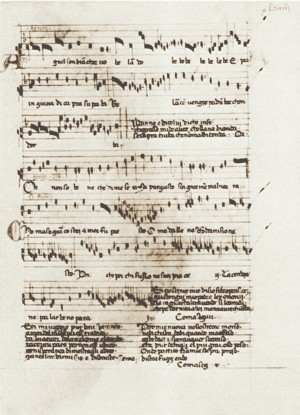 Panciatichi 26 | 1380-1450
Panciatichi 26 | 1380-1450collocazione: Florence, Biblioteca Nazionale Centrale [I-Fn], Panciatichiano 26.
descrizione: 115 paper ff. (29·5 × 22 cm), with 2 modern flyleaves at front and 3 at back (fig.36). Foliation: 1–5 (modern: index), i–cx (15th or 16th century). Structure: index (5 folios) followed by 11 gatherings, each of 5 bifolios (a quinion).
redazione: the main corpus is in 4 (Nádas) or 5 (Campagnolo) hands, with additions made both by the main scribes and by later scribes; the Italian notation (especially when in duodenaria or octonaria) has in many cases been Frenchified and changed according to the tastes of the copyists.
storia: main corpus: 1380–90 (Fischer, Campagnolo) or c1400 (Pirrotta, Nádas). The additions fall into 3 (Nádas) or 5 (Fischer) groups: (1) directly after completion of main corpus; (2) shortly after the main corpus; (3) 1400–20; (4) after 1420; (5) 1430–50 (in void notation); the earliest of the Florentine Trecento MSS, it belonged to the Florentine Panciatichi collection founded in the 16th century by V. Borghini and extended by Panciatichi.
contenuto: 185 pieces: 59 madrigals, 15 cacce, 85 ballatas, 15 French ballades, 9 rondeaux, 2 virelais; the main corpus derives directly from a circle of composers associated with Landini; the contents are as follows: 2-voice ballatas by Landini (gatherings 1–2), 3-voice ballatas by Landini (gatherings 3–4), madrigals and cacce by Landini and earlier composers (gatherings 5–9), mostly 3-voice madrigals by earlier composers (gathering 10), French works (later additions and the whole of gathering 11) of which 5 have concordances with F-CH 564. Date of music: from 1340 to 1440–50. Composers: Landini (86), Jacopo da Bologna (22), Giovanni da Cascia (18), Piero (8 or 9), Donato da Cascia (5), Gherardello da Firenze (5), Lorenzo da Firenze (5), Machaut (5) and others.
bibliografia:
– PMFC, iv (1958), uses I-Fn 26 as
primary source;
– N. Pirrotta: ‘Florenz’, §C,
MGG1;
– L. Schrade: Commentary to PMFC, iv (1958),
13–23;
– RISM, B/IV/4 (1972), 835–96;
–
Census-Catalogue of Manuscript Sources of Polyphonic Music, 1400–1550,
RMS, i/1 (1979), 231–2;
– Long (1981), 179–90;
–
J. Nádas: ‘The Structure of MS Panciatichi 26 and the Transmission
of Trecento Polyphony’, JAMS, xxiv (1981), 393–427;
– Nádas (1985), 56–117;
– S. Campagnolo: ‘Il codice
Panciatichi 26 della Biblioteca Nazionale di Firenze nella tradizione delle
opere di Francesco Landini’, ‘Col dolce suon che da te piove’:
studi su Francesco Landini e la musica del suo tempo in memoria di Nino
Pirrotta, ed. M.T.R. Barezzani and A. Delfino (Florence, 1999),
77–119.
facsimile: F.A. Gallo, ed.: Il codice musicale Panciatichi 26 della Biblioteca Nazionale di Firenze (Florence, 1981) [facs. with introduction]; see also individual composers Wolf, 244ff;
immagine · carta 49r (da Nádas 1981, 425)
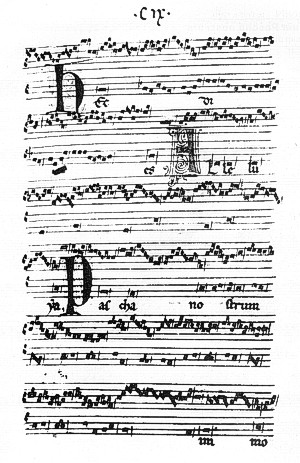 Codice fiorentino (F) | 1280-90 |
Codice fiorentino (F) | 1280-90 | collocazione: Firenze, Biblioteca Medicea Laurenziana [I-Fl] , Plut. 29.1 [F].
descrizione: 441 ff. (23·2 × 15·7
cm); la fogliazione antica i–ccclv (comincia dopo un primo foglio di
guardia n.n. recante al verso un'illustrazione a tutta pagina) rivela che
mancano i ff. 49–64, 94, 185–200 e 255–6; il sistema moderno
(comunemente adottato) prosegue la fogliazione da 356 to 476 (ignorate le
lacune dopo i ff. 398 e 414); la fogliazione moderna (usata nella ![]() riproduzione digitale = rd): 1–441;
fascicoli insolitamente corposi, in genere di 7–11 bifogli.
riproduzione digitale = rd): 1–441;
fascicoli insolitamente corposi, in genere di 7–11 bifogli.
redazione: un'unica mano, a parte i brani mensurali ai
ff. 252v–254v [post rd 219v] e un conductus monofonico aggiunto a ff. 451r–v [rd 416].
Miniature: atelier
parigino di Johannes Grusch (Branner 1972), la cui opera si trova anche
nei ms. F-R 277 (Missale di Rouen, 1231–45), F-Pn lat. 15613
(Breviario di Parigi, ca 1250), F-Pn lat. 9441 (Missale di
Parigi, ca 1250).
notazione: quadrata (modale, a parte i brani mensurali ai ff. 252v–254v; il conductus aggiunto ai ff. 451r–v distingue insolitamente fra longa e dupex longa).
contenuto: da Ludwig 1910 si contano 11 fascicoli. Fasc. 1 (ff. 1–13): 3 organa quadrupla, 3 conductus a 4 voci (actually pairs of conductus for 2 voices set one above the other), 9 clausulas for 3 voices (for the first the top part was never entered). Fasc. 2 (ff. 14–47): 26 organa tripla, 5 clausulas for 3 voices, 3organa tripla (the third incomplete because of missing quaternion). Fasc. 3 (ff. 65–98): 55 organa dupla per l'Ufficio, di cui 19 sono intonazioni di Benedicamus Domino o di Domino. Fasc. 4 (ff. 99–146): 61 organa duplaper la Messa. Fasc. 5 (ff. 147–84): 462 clausulas for 2 voices. Fasc. 6 (ff. 201–62): 59 conductus for 3 voices, of which 2 are based on the upper voices of clausulas and have the clausula tenors appended, and an organum triplum Benedicamus with one text for the upper parts; 2 textless mensural pieces, the second incomplete, both found incomplete elsewhere (see G.A. Anderson, JAMS, xxvi, 1973, p. 293). Fasc. 7 (ff. 263–380): 130 conductus for 2 voices. Fasc. 8 (ff. 381–98): 26 Latin motets for 3 voices in which the top voices share the same text and are written in score, the tenor following at the end. Fasc. 9 (ff. 399–414): 43 Latin motets, all for 2 voices except 3 for 3 voices, where the top voices have different texts and are written successively. Fasc. 10 (ff. 415–62): 83 monophonic Latin conductus. Fasc. 11 (ff. 463–76): 60 monophonic Latin rondeaux.
storia: most probably written in Paris in the 1240s. The latest datable piece in the main hand is Aurelianis civitas (f. 439v) which relates to incidents in Orléans in 1236. The added Sol eclypsim patitur (f. 451) is a lament for Ferdinand III ‘El Santo’ of León and Castile (d 1252), nephew of Blanche of Castile. The MS later belonged to Piero di Cosimo de’ Medici (d 1469); first book (Antiphonarium) now in one of the cases of books on mathematics in his son’s library.
bibliografia:
– H. Husmann, Florenz,
§D, in MGG1
– Ludwig (1910), 57
– H. Spanke, ‘Das lateinische Rondeau’, Zeitschrift für
französische Sprache und Literatur, liii (1929–30),
113–48
– F. Gennrich, Bibliographie der ältesten
französischen und lateinischen Motetten, SMM, ii (Darmstadt,
1957)
– RISM, B/IV/1 (1966), 610–788
– R. A.
Baltzer, ‘Thirteenth-Century Illuminated Miniatures and the Date of
the Florence Manuscript’, JAMS, xxv (1972), 1–18
– R.
Branner, The Johannes Grusch Atelier and the Continental Origins of the
William of Devon Painter, «Art Bulletin», liv/2 (1972),
24
– G. A. Anderson, ‘The Rhythm of the Monophonic
Conductus in the Florence Manuscript as Indicated in Parallel Sources in
Mensural Notation’, JAMS, xxxi (1978), 480–89
– R. A.
Baltzer, Le ‘Magnus Liber Organi’ de Notre-Dame de Paris, v: Les
clausules à deux voix du manuscrit de Florence, Biblioteca
Medicea-Laurenziana, Pluteus 29.1, fascicule V (Monaco, 1995)
facsimile:
–
L. Dittmer, Firenze,
Biblioteca-Mediceo-Laurenziana, Pluteo 29.1, Brooklyn, NY, 1966–7
[I-Mc]
–
E.H. Roesner, Antiphonarium seu
Magnus liber de gradali et antiphonario: Color Microfiche Edition of the
Manuscript Firenze, Biblioteca Medicea Laurenziana, Pluteus 29.1: Introduction
to the ‘Notre-Dame Manuscript’ F, Munich, 1996 (Codices
illuminati medii aevi, 45)
immagine · carta 109r, Alleluia Pascha nostrum
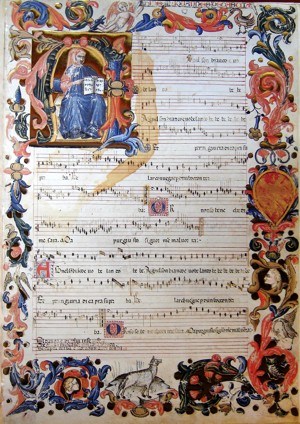 Codice Squarcialupi | 1415
Codice Squarcialupi | 1415collocazione: Florence, Biblioteca Medicea Laurenziana [I-Fl], Med. Pal. 87.
descrizione: 216 parchment ff. (40·5 × 28·5 cm), 2 original parchment flyleaves at the front (independent of the rest of the MS), and 5 modern paper flyleaves (3 at the front, 2 at the back). Foliation: i–cxvi (original). Structure: 20 gatherings of 3 to 10 bifolia each.
redazione: 1 hand for the texts, 3 (Fischer) or 4 (Nádas) very similar hands for the music.
storia: c1410–15 (Bellosi, Nádas), almost certainly from the Florentine monastery of S Maria degli Angeli; it is not certain whether Paolo da Firenze was involved in the preparation of the MS; it was in the possession of Antonio Squarcialupi in the 15th century, passed thereafter via his nephew R. Bonamici to Giuliano de’ Medici (1512–13), from there to the Biblioteca Palatina, and then to the Biblioteca Medicea Laurenziana.
contenuto: 353 (or 354) pieces (150 unica), of which 2 appear twice: 115 madrigals, 12 cacce, 227 ballatas. Date of music: 1340–1415. Composers: the pieces are arranged in chronological order by composer: Giovanni da Cascia (12), Jacopo da Bologna (28), Gherardello da Firenze (16), Vincenzo da Rimini (6), Lorenzo da Firenze (17), Donato da Cascia (15), Niccolò da Perugia (36), Bartolino da Padova (37), Landini (146), Egidius and Guilielmo de Francia (5 in all), Zacara da Teramo (7), Andreas de Florentia (29); 16 folios have been left blank to accommodate the music of Paolo da Firenze between Lorenzo and Donato, and 22 folios for that of Jovannes Horganista de Florentia (Giovanni Mazzuoli) at the end. A portrait of each composer appears with the ascription of his works.
bibliografia:
– J. Wolf, ed.: Der Squarcialupi-Codex
Pal. 87 der Biblioteca Medicea Laurenziana zu Florenz (Lippstadt, 1955) [see
corrections by K. von Fischer, Mf, ix (1956), 77–89, and L. Schrade,
Notes, xiii (1955–6), 683 only];
– see also individual composers
Wolf, 228;
– B. Becherini: ‘Antonio Squarcialupi e il codice
Mediceo Palatino 87’, L’Ars Nova italiana del Trecento I: Certaldo
1959, 141–96;
– K. von Fischer: ‘Paolo da Firenze und der
Squarcialupi-Kodex (I-Fl 87)’, Quadrivium, ix (1968),
5–24;
– RISM, B/IV/4 (1972), 755–832,
–
Nádas (1985), 362–458;
– F.A. Gallo, ed.: Il codice
Squarcialupi (Florence, 1992) [incl. J. Nádas: ‘The Squarcialupi
Codex: an Edition of Trecento Songs, ca 1410–15’, 19–86; L.
Bellosi: ‘Il maestro del codice Squarcialupi’, 146–57; M. Ferro
Luraghi: ‘Le miniature’, 159–92; see also reviews by M. Bent,
EMH, xv (1996), 251–69; J. Haar, JAMS, xlix (1996), 145–55]
facsimile: F.A. Gallo, ed.: Il codice Squarcialupi (Florence, 1992) [facs. with essays]
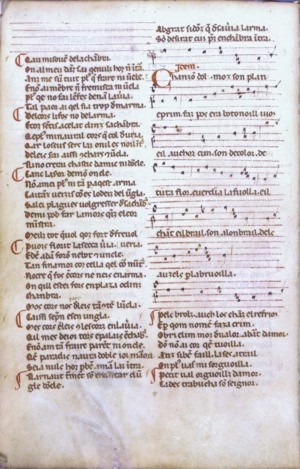 Canzoniere Ambrosiano (*G) | xiii-xiv sec.
Canzoniere Ambrosiano (*G) | xiii-xiv sec.collocazione: Milan, Biblioteca Ambrosiana [I-Ma], S.P.4 (formerly R 71 sup.).
descrizione: 2 + 142 parchment leaves, 27 × 18 cm.| Foliation: modern pencil 1–141; the first 2 leaves, with the medieval index, are unnumbered. Structure: originally 130 leaves in 15 quaternions and a quinternion, to which 2 gatherings (a quaternion and a binion, plus a single leaf tipped in) of slightly smaller dimensions were added at the end; the final leaf is heavily damaged; medieval index on a damaged binion at the beginning; 2 paper flyleaves at the beginning give an index of authors in a modern hand. Layout: 2 columns with 37 lines per column; generally in verse format (one verse per line), although the scribe sometimes attempted to consolidate verses into the same line, often erasing text already written to do so.
redazione: Decoration: large red initials begin each song; red strophe caputs; red rubrics with composers' names. No space was ruled off for any of these items, so they are written in the margins and on the music staves. Text scribes: ff.1–130, 1 text scribe; different hand on ff.131–140v. Notation: red staves of 4–8 lines above first stanzas and first verse of second stanzas; 1 music scribe, square notation without mensural values; music added before rubrics and decoration, not aligned carefully with text syllables.
storia: Date and provenance: early 14th century (date 1318 in a colophon on f.142 is later than main text hand), Lombardy; evidently resided in France before being acquired by the Biblioteca Ambrosiana.
contenuto: ff.1–90v: 170 lyric songs, 81 with melodies; ff.90v–101: 31tensos and partimens without staves; ff.101–116: 32 lyric songs with empty staves; ff.116–128v: ensenhamens and other long non-strophic works by Arnaut de Mareuil, Garin le Brun and others, without staves; ff.129–130v: 30 anonymouscoblas without staves; ff.131–140v: Ensenhamen d'onor of Sordello. Melodies: Peirol (14), Folquet de Marseille (13), Gaucelm Faidit (11), Bernart de Ventadorn (10), Aimeric de Peguilhan (6), Peire Vidal (5), etc.
bibliografia:
– Beck, 14–18 [with list of melodies]
– G.
Bertoni, ed.: Il canzoniere provenzale della Biblioteca Ambrosiana R.71 sup.
(Dresden, 1912) [edn of texts]
– U. Sesini, ed.: Le melodie trobadoriche nel
canzoniere provenzale della Biblioteca Ambrosiana R.71 sup. (Turin, 1942) [edn
of melodies, facs. of ff.1–41]
– Aubrey (1996), 38–9, 43–6
facsimile: (delle sole prime 41 cc.) Sesini
immagine · c. 37v (Arnaut Daniel, Chanson do·lh)
collocazione: Modena, Biblioteca Estense e Universitaria [I-MOe], a.X.1.11.
descrizione: i + 139 (of an original 150) + i paper ff., 41·2 × 28·5 cm (fig.39). Original foliation of inked Roman numerals, and a modern pencil foliation. Covers of brown leather over boards, dating from 19th century; portions of an original index remain, with musical incipit for each piece. Originally 15 gatherings of 5 bifolios each; only 3 of the original 10 folios of the first gathering (which included only the index) remain.
redazione: Bulk of the MS copied by a single scribe, c1440–50, probably for the Este court in Ferrara; various pieces added from time to time on blank folios and at bottoms of pages.
contenuto: 71 motets, 29 hymns, 22 brief liturgical works and 9 Magnificat settings, by Du Fay (48), Dunstaple (31), Binchois (13), Leonel Power (8), Forest, Plummer, Benoit, Fedé, Benet and others. Only 9 of the 131 pieces are anonymous.
sezioni: Apparently all for Vespers, and organized in 5 sections: hymns (beginning on f.1); miscellaneous liturgical pieces (f.21v); Magnificat settings (f.31); antiphons and motets by continental composers (f.51); and motets by English composers (f.81). The most important surviving source of English motets (contains 51).
bibliografia:
– A. B. Scott, Coherence and
Calculated Chaos: the English Composers of Modena, Biblioteca Estense, a.X.1.11
(lat. 471), diss., U. of Chicago, 1969
– C. Hamm and A.B.
Scott, A Study and Inventory of the Manuscript Modena, Biblioteca
Estense, a.X.1.11 (ModB), «Musica disciplina», xxvi (1972),
101–43
– L. Lockwood, Music in Renaissance Ferrara,
1400–1505, Oxford, 1984
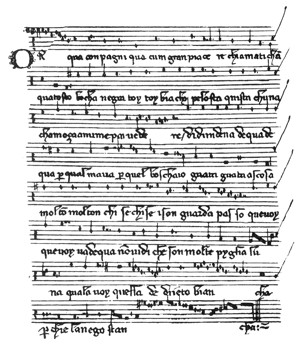 Codice Rossi | 1360 |
Codice Rossi | 1360 | collocazione: Città del Vaticano, Biblioteca Apostolica Vaticana [I-Rvat], Rossi 215 — che si completa con il frammento conservato ad Ostiglia, Opera Pia G. Greggiati, Biblioteca Musicale, s.s.
descrizione: Originally at least 32 ff. (4 quaternions; c23 × 16·8 cm), of which 14 parchment folios survive in Rvat (from between ff.8 and 18, and after f.23) together with 10 inserted modern paper folios and modern flyleaves, and 4 parchment folios in I-OS. Foliation: Rvat: i–viii, xviii–xxiii; OS: xxv–xxvi, xxxi–xxxii (all original). Structure: at least 4 distinct fascicles, of which the second is entirely lost; the surviving folios are in a single hand.
redazione: mid- to late 14th century (Fischer c1350, Pirrotta c1370), from Padua-Verona region.
storia: Rvat possibly came from the library of Cardinal Domenico Capranica (1400–58), belonged in the 19th century to the Italian collector G. F. de Rossi, passed at his death in 1854 to Jesuit libraries in Linz and thence Vienna, and in 1922 to the Vatican.
contenuto: the fragments together contain 37 pieces (Rvat 29, OS 8): Rvat has 22 madrigals (1 of which is canonic), 1 caccia, 1 rondello, 5 monophonic ballatas; OS 8 madrigals. Date of music: c1325–55. Composers: all pieces are anonymous, but concordances ascribe 2 to Piero and 2 to Giovanni da Cascia (with 1 further ascription to him possible for no.1).
bibliografia:
– J. Wolf: ‘Die Rossi-Handschrift
215 der Vaticana und das Trecento-Madrigal’, JbMP 1938, 53–69
[Rvat];
– CMM, viii/2 (1960), 15–46 [excluding OS];
– O. Mischiati: ‘Uno sconosciuto frammento appartenente al codice Vaticano
Rossi 215’, RIM, i (1966), 68–76 [OS];
– W.T. Marrocco:
‘The Newly-Discovered Ostiglia Pages of the Vatican Rossi Codex 215: the
Earliest Italian Ostinato’, AcM, xxxix (1967), 84–91;
– V.
Guaitamacchi: Madrigali trecenteschi del frammento ‘Greggiati’ di
Ostiglia (Bologna, 1970);
– RISM, B/IV/4 (1972), 981–4 [OS],
1020–27 [Rvat];
– PMFC, viii (1972);
– PMFC, ix
(1978);
– M.P. Long: Musical Tastes in Fourteenth-Century Italy:
Notational Styles, Scholarly Traditions, and Historical Circumstances (diss.,
Princeton U., 1981), 210–12;
– N. Pirrotta:
‘«Arte» e «non arte» nel frammento
Greggiati’, L’Ars Nova italiana del Trecento, v, ed. A. Ziino
(Palermo, 1985), 200–17
facsimile:
–
G. Vecchi, ed.: Il canzoniere musicale del
codice Vaticano Rossi 215, MLMI, iii/2 (1966) [facs. of the two sources
together]
–
N. Pirrotta, ed.: Il codice Rossi 215
(Lucca, 1992) [facs. with introduction]
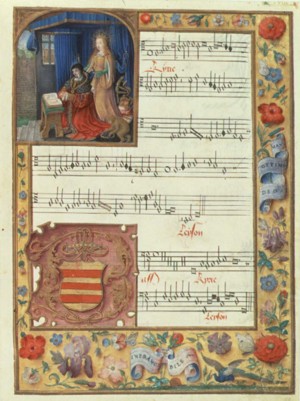 Codice Chigi | 1500 |
Codice Chigi | 1500 | collocazione: Città del Vaticano, Biblioteca Apostolica Vaticana [I-Rvat], Chigi C VIII 234.
descrizione: 289 parchment ff., 36·3 × 27·8 cm. Red velvet binding.
redazione: Probably prepared for Philippe Bouton, and copied by the Netherlands scribe B, perhaps Martin Bourgeois.
storia: It was probably in Spain early in its history, for it carries a table of contents in Spanish. Later owned by Pope Alexander VI.
contenuto: 40 pieces, including 20 masses, 1 Credo and 19 motets, by Ockeghem (15), Regis (5), Compère (4), Josquin (2), La Rue (2), Agricola, Barbireau, Brumel, Busnoys, Févin, Weerbeke, Isaac, Madrid and Mouton, with 3 anonymous.
bibliografia:
– H. Kellman, «JAMS»,
xi (1958), 6-19 —
– F. Fitch, Johannes Ockeghem: Masses
and Models, Paris 1997 —
– H.-J. Winkler, Bemerkungen zur
Handschrift Vatikan, Biblioteca Apostolica Vaticana, Chigi C VIII 234, in Gestalt und Entstehung musikalischer Quellen im 15. und 16. Jahrhundert,
ed. M. Staehelin, Wiesbaden 1998, 65–74 —
– H. Kellman, The Treasury of Petrus Alamire: Music and Art in Flemish Court Manuscripts,
1500–1535, Ghent 1999
facsimile: H. Kellman (ed.), Vatican City, Biblioteca Apostolica Vaticana, MS Chigi C VIII 234, Mew York 1987 (Renaissance Music in Facsimile, 22) [I-Mc]
immagine: carta20r
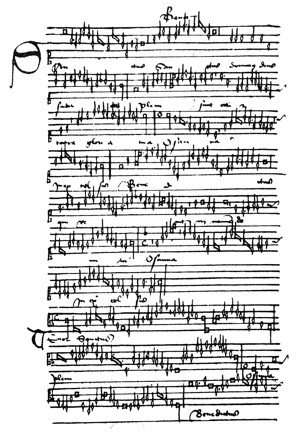 Codici trentini 87-93 | 1435-1475 |
Codici trentini 87-93 | 1435-1475 | collocazione: Trento, Castello del Buonconsiglio [I-TRmp], Monumenti e Collezioni Provinciale 1374–1379 (formerly 87–92) · Trento, Biblioteca Capitolare [I-TRcap]· Referred to by the sigla I-TRmp 87 (=1374) to I-TRmp 92 (=1379) and I-TRcap (‘Trento 93’).
descrizione: These manuscripts contain an immense repertory spanning the first 75 years of the 15th century and form the largest and most important collection from the entire century.
The manuscripts underwent a complete restoration in 1975. The seven MSS, copied on paper, are c30 × 20 cm.
Cod. 87 e 92: TRmp 87 (23 gatherings, 265 folios) and TRmp 92 (22 gatherings, 264 folios) are the oldest of the set, having been copied c1435–50 at several places in northern Italy and Piedmont. They were apparently brought to Trent as a collection of fascicles and bound into large MSS when the other five were bound. The fascicles were at that time divided up equally to make the two MSS, and some originally belonging together were split between the two. Four distinct layers can be identified.
Gatherings 15–17 and 19 of TRmp 87, and 22–3 of TRmp 92. The first layer contains the earliest repertory in all of the Trent MSS: early mass Ordinary sections and motets by Du Fay; pieces by Grossin, Zacara da Teramo, Brassart, Vide, Verben, Ludvicus de Arimino and Tyling; and a scattering of pieces by such English composers as Dunstaple.
Gatherings 1–9 and 11–12 of TRmp 87 and 13–20 of TRmp 92. The large second section, with common scribes, paper and watermarks, has mass Ordinary sections, motets, hymns and Magnificat settings, by Du Fay, Binchois, Brassart, Liebert, Velut, Merques, Grossin and others, and a number of English pieces by Dunstaple, Leonel Power, Forest and Benet. A series of clearly differentiated layers can be detected.
Gatherings 22–3 of TRmp 87. The paper, scribe and watermarks in the third section are of a sort found nowhere else in the Trent MSS. Magnificat settings, mass sections, hymns and motets are scattered in no apparent order. Nine pieces are attributed to H. Battre, otherwise unknown, and there is one attribution each to Du Fay and Binchois; the remaining pieces are anonymous. Watermarks and repertory suggest an origin somewhere in north-east France.
Gatherings 1–12 of TRmp 92. The fourth section is unrelated, in paper, scribe and watermarks, to the other Trent MSS. Its contents form essentially a series of mass introits, each followed by a mass Ordinary cycle, though this original organization is obscured in places by pieces added later. Wright (1989) has shown that this section is related to the second and third sections of Aosta 15 and that it probably originated in the circle of Felix V, in the Savoy-Basle region.
Cod. 88-91 e 93: The remaining five MSS were mostly copied in Trent 1445–75; the principal scribe was Johannes Wiser, from Tione, 32 km west of Trent.
TRmp 90, the earliest of the group, is made up of 39 gatherings comprising 465 folios. Gatherings 1–6 contain introits, 6–9 Kyries, 9–10 Glorias, 15–19 Credos, 20–24 Sanctus and Agnus settings, 26 French secular pieces, 27–8 and 33–9 masses, 32–3 music for Vespers, and the rest miscellaneous works. Du Fay is the most widely represented composer, followed by Pullois, Binchois, Brassart, W. de Rouge and Johannes Legrant. There are a number of English pieces, by Leonel Power, Dunstaple, Benet, Bedyngham and Plummer; most are anonymous, but many are obviously by English composers.
Trent 93 has 33 gatherings, 382 folios. The first 30 gatherings almost exactly duplicate TRmp 90 – the same pieces are in the same order and Trent 93 was plainly used as its exemplar. Gathering 31 has mostly textless pieces, 32 German and French secular works, and 33 mostly hymns. Almost all of the pieces in the last three gatherings are anonymous; the few attributions are to such obscure composers as Opilionis and Villete.
TRmp 88, the next copied, has 35 gatherings with a total of 422 folios. The first ten gatherings contain mass Ordinary sections, mostly arranged in cycles, as do gatherings 22–8 and 31–5. Mass Propers, also arranged in sets, are found in gatherings 10–19 and 30, vesper hymns in gathering 20, Magnificat settings in gathering 29, and miscellaneous pieces in the rest. There are very few composer attributions; the identified pieces are by Du Fay, Ockeghem, Touront, Domarto, Cornago and a few others (the repertory is thus somewhat later than that of the preceding MSS). Feininger (1947) attributed a large number of mass Proper cycles to Du Fay on stylistic grounds.
TRmp 89 (36 gatherings, 425 folios) is organized differently. Gatherings 1–7, 10, 14, 18 and 22–35 are taken up with mass Ordinary cycles, usually one to each gathering; Magnificat antiphons occupy gatherings 8–13; and 16 has seven vespers hymns. This MS apparently existed originally as a series of fascicle-MSS: independent groups of folios containing a single composition, or a set of related pieces, with the outer two pages blank. These were later brought together, bound as a single MS, and additional pieces were copied on some of the blank folios. Most pieces are anonymous. Among identified composers are Touront, Busnoys, Barbingant, Du Fay (late works only), Hermannus de Atrio and Martini; the repertory comes from mid-century and slightly after.
TRmp 91 (22 gatherings, 259 folios) was the last of the set to be copied. Mass Ordinary cycles and sections take up gatherings 1–3, 5–7, 9–16 and 19–22,Magnificat settings and hymns 16–18; the other sections contain miscellaneous pieces copied in no apparent order. Again there are few composer attributions, but the presence of pieces by Vincenet, Faugues, Busnoys, Touront and Martini suggests that the repertory is even later than that of TRmp 89.
fortuna: Though these MSS have been known to scholars for almost a century, much work has been done only in more recent years: identifying more of the many hundreds of anonymous pieces; more precise dating; determination of why they were copied, and to what use they were put; investigation of liturgical practice of the time as revealed in these sources. It seems unlikely that they were performance MSS, particularly TRmp 88–91, because of their size, the careless nature of much of the copying and the many errors that would seem to make it impossible to sing from them. They appear to be a vast anthology, possibly reflecting the polyphonic repertory of churches and court chapels in northern Italy and southern Germany, probably including the imperial court.
bibliografia:
– L. Feininger (ed.), Documenta polyphoniae liturgicae, I ser., I, Roma, 1947
– T. Ward, The Structure of the Manuscript Trent 92–1,
«Musica disciplina», xxix (1975), 127–47
– M.
Bent (ed.), Four Anonymous Masses, «EECM», xxii
(1979)
– N. Pirrotta - D. Curti (ed.), I codici musicali
trentini [I], Trento 1985
– P. Wright 1989
– S.E. Saunders, The Dating of the Trent Codices from their
Watermarks, New York, 1989
– A.P. Leverett, A
Paleographical and Repertorial Study of the Manuscript Trento, Castello del
Buonconsiglio, 91 (1378), diss., Princeton U., 1990
–RISM, B/IV/5 (1991), 461–547
– M. Gozzi, Il Manoscritto Trento, Museo Provenciale d’Arte, cod. 1377 (Tr 90),
Cremona, 1992
– P. Wright (ed.), I codici musicali
trentini [II]: Trento 1994
– R. Strohm, Trenter
Codices, in MGG2
facsimile: Codex tridentinus, 7 voll. a cura di Vivarelli e Gullà, Roma 1968-70
immagine: codice 92, carta 82v · inizio di un Sanctus di John Benet, (†1458) (da Apel, Notazione, facs. 24)
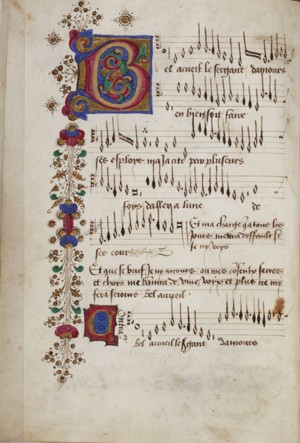 Mellon Chansonnier | 1476 |
Mellon Chansonnier | 1476 | The Aragonese court in Naples was most probably a focal point for the cultivation of the French chanson in that region. Although only a few of the Neapolitan MSS described below can be linked conclusively with the Aragonese court itself, Atlas (1975–6) was able to establish their Neapolitan provenance quite convincingly, using evidence derived from a collation of concordances and a comparison of variant readings of the same pieces in different sources.
collocazione: New Haven, Yale University [US-NHub], Beinecke Rare Book and Manuscript Library, Ms. 91.
descrizione: 81 parchment ff., 19·2 × 13·5 cm.
redazione: Copied by a single scribe, c1476. ![]()
contenuto: 57 pieces, mostly with French texts, but also including a few works with Spanish, Latin, Italian and English texts. Among composers represented are Busnoys (15), Vincenet (4), Du Fay (4), Ockeghem (3), Joye, Tinctoris, Frye, Caron, Regis, Morton, Barbingant and Hayne van Ghizeghem.
bibliografia:
– M. Bukofzer, An Unknown Chansonnier of
the 15th Century, «MQ», xxviii (1942), 14–49
– Edn by L.
Perkins and H. Garey (New Haven and London, 1979)